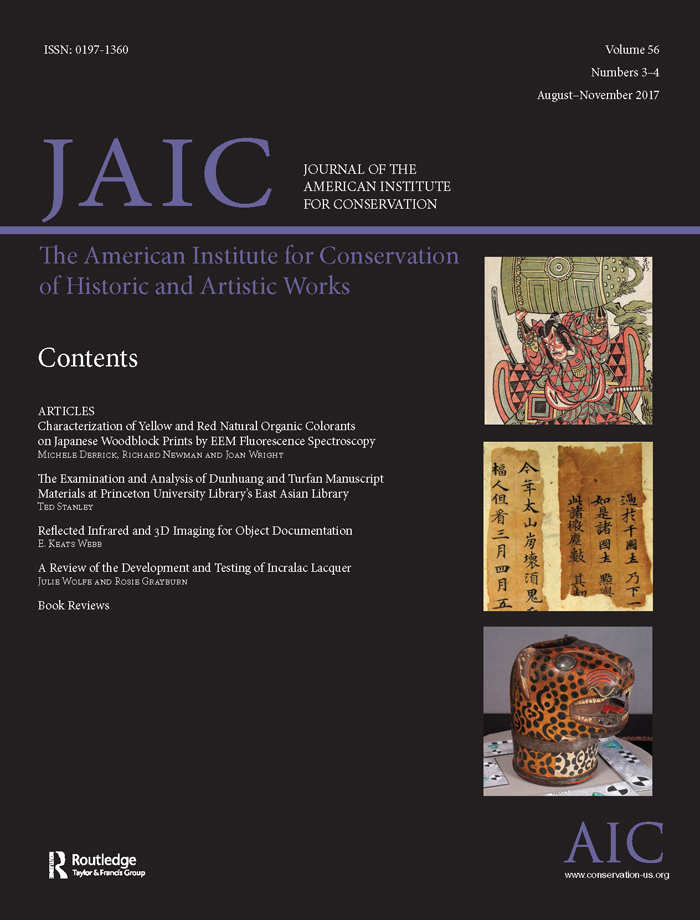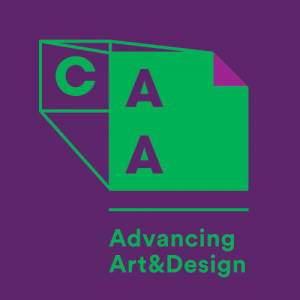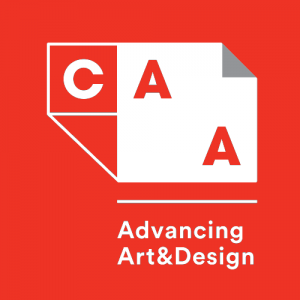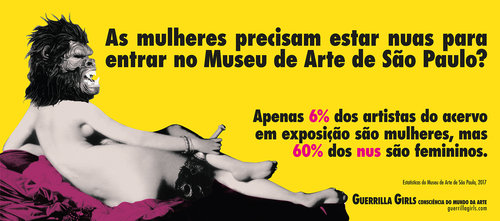CAA News Today
Show Your Support for the Arts and Humanities
posted by CAA — May 14, 2018
With an ever-changing academic and museum landscape, it’s clear that CAA must respond to the evolving needs of its members. We can no longer be an organization satisfied only with producing a large annual conference and quarterly journals. We must be a leader in the national conversation about the future of art history and studio arts education; indeed we can work to strengthen all humanities departments in colleges and universities. In addition, the CAA Annual Conference needs to be a supportive environment where everyone can connect as colleagues and friends year round, and to do this, we need your help.
As the world’s largest international visual arts association, we can unite to bridge the generational divide in the field and create a sense of belonging for younger members. We can understand where barriers exist and find ways to break them down. We can provide leadership to solve diversity and inclusion issues on college campuses.
It is our goal to make sure everyone who has a stake in the visual arts, from practicing artists to teachers of art, art history, design, curatorial studies, and museum practices at the college level—at every organization from the loftiest research institution to the most rural community college—feel included and welcomed.
Please consider making a tax-deductible donation that will help the next generation of art historians and visual artists. Your support directly goes to travel scholarships, publications, and reduced membership and registration for student and independent members. Together, we can work to provide everyone in the field the essential resources, contacts, mentorship, and advocacy they need.
Thank you for your generosity and with my best wishes,

Hunter O’Hanian
Executive Director and CEO
Affiliated Society News for April 2018
posted by CAA — Apr 17, 2018
Affiliated Society News shares the new and exciting things CAA’s affiliated organizations are working on including activities, awards, publications, conferences, and exhibitions. For more information on Affiliated Societies, click here.
Society of Historians of Eastern European, Eurasian, and Russian Art and Architecture (SHERA)
Society of Historians of Eastern European, Eurasian, and Russian Art and Architecture (SHERA) is an affiliate organization of CAA and ASEEES and partner organization of SAH; elected Board Officers are Eva Forgacs, President; Karen Kettering, Vice-President / President Elect; Alice Isabella Sullivan, Secretary / Treasurer; Yelena Kalinsky, Listserv Administrator; Corina L. Apostol, News Editor; and Anna P. Sokolina, SHERA-SAH Liaison. During recent elections, SHERA reelected Members-at-Large Hanna Chuchvaha, Nic Iljine, Natalia Kolodzei, and Andrey Shabanov.
Thanks to a generous donation from an anonymous donor, SHERA is offering annually two SHERA Graduate Student Travel Grants of 1,500 USD each. The grant is given for five consecutive years (2017-2021), to help defray travel costs for a graduate student – SHERA member, presenting a paper at the CAA Annual Conference or the ASEEES Annual Convention. Applications will be evaluated based on the academic merit of the paper topic and financial need. SHERA is especially committed to subsidizing a graduate student who is attending the conference for the first time or who has no local institutional resources for travel support. Calls for application will be posted to H-SHERA.
Association of Academic Museums & Galleries (AAMG)
AAMG’s next annual conference will be held June 21-24, 2018, at the Lowe Art Museum (University of Miami).
Our 2018 conference is a partnership with UMAC (University Museums and Collections), a committee of ICOM (International Council of Museums). We encourage members of either organization to join us and explore this year’s theme:
Audacious Ideas: University Museums and Collections as Change-Agents for a Better World
We live in a dangerous, often unstable, and environmentally compromised world. What can academic museums, galleries, and collections do to remedy this situation? If we are dedicated to teaching and training new generations of students, to serving increasingly diverse communities, how do we make a positive difference? How do we know we are making that difference? Let’s share great ideas and pressing concerns and learn and network with our global colleagues
Take a sneak peek at sessions, workshops, and more
Association for Latin American Art
ALAA would like to announce the formation of a new journal for scholars in our field:
Latin American and Latinx Visual Culture
Call for Submissions 2018
Latin American and Latinx Visual Culture
A new journal to be published by University of California Press
Latin American and Latinx Visual Culture (LALVC) is a new quarterly peer-reviewed academic journal published by the University California Press, scheduled for publication in January 2019. The editorial staff is now reviewing submissions.
Focused on Latin American and Latinx visual culture of all time periods — ancient, colonial, modern, and contemporary – LALVC publishes on Mexico, Central America, South America, the Caribbean, and the United States, as well as on communities in diaspora. LALVC considers all aspects of visual expression, including, but not limited to, art history, material culture, architecture, film and media, museum studies, pop culture, fashion, public art and activism. We welcome a range of interdisciplinary methodologies and perspectives. Additionally, the journal seeks to inspire and advance dialogue and debate concerning pedagogical, methodological, and historiographical issues.
We welcome scholarly research articles (10,000 to 12,000 words) written in English, Spanish, or Portuguese, as well as in American indigenous languages. Contact the editors if you are interested in proposing a guest-edited DIALOGUES section or writing a review of a book or exhibition.
To submit your work for review, or for any inquiries, please contact the editorial staff at LALVCsubmissions@ucpress.edu. Please review the journal’s author guidelines prior to submission.
Deadline for submissions to be considered for the first issue is June 1, 2018.
Association for Latin American Art
Fifth Triennial Conference
Chicago, March 8-9, 2019
CALL FOR PAPERS
The World Turned Upside Down:
Arts of Oppression and Resistance in the American Hemisphere
In keeping with these uneasy times, this Triennial welcomes studies of artworks and visual practices that either materialize powers of a presumed establishment or push back against its projected dominance, made or enacted anytime during more than 3000 years of Latin American history. An agent characterized as “radical” is often understood to challenge the fundamental nature of something, be it an established governance framework, broadly accepted social traditions, propagated religious strictures, or other oppressive cultural forces. This conference is interested in the fundamental role that art and architecture has played in both compounding constrictive powers and in giving shape to resistance, whether localized or widespread, subtle or indeed radical.
The committee therefore seeks proposals that offer specific answers to broad questions such as: How has art functioned to secure compliance, to encourage conformity, to intimidate, or to aestheticize state violence? Or in contrast, how do artistic practices demonstrate the will to resist, to protest, or to aggressively revolt? Case studies might use gender as a helpful index for exploring, for instance, visual culture that scaffolds patriarchal structures or works that deliver feminist challenges. Oppression and resistance could alternatively be viewed through the lens of form, perhaps with adherence to stylistic norms that affirm a particular worldview, or by way of notable artistic departures that seek to turn that world upside down. We encourage paper proposals that focus on overlooked and neglected artistic traditions, or offer new interpretations of canonical works of art. Submissions engaging methodologies drawn from decolonial, postcolonial, and critical race studies, as well as intersectional approaches to visual culture, among others, are also welcomed.
To be considered, participants must be members of the Association for Latin American Art. Please submit a CV as well as an abstract of approximately 500 words by Sept. 1, 2018 via e-mail to Delia Cosentino: dcosent1@depaul.edu
American Society for Aesthetics
The American Society for Aesthetics is pleased to announce meetings and conferences in the coming months. Non-members are welcome to attend:
- Conference: The Philosophy of Portraits, Co-sponsored with the University of Maryland, College Park, April 12-14, 2018. At the National Portrait Gallery and the University of Maryland. For on-line registration, complete schedule and list of speakers: http://aesthetics-online.org/events/EventDetails.aspx?id=941280
- ASA Eastern Meeting, Courtyard Marriott, Philadelphia, April 20-21, 2018. For on-line registration and program: http://aesthetics-online.org/events/EventDetails.aspx?id=969935&group=
- ASA Rocky Mountain Division Meeting, Drury Plaza Hotel, Santa Fe, NM, July 6-8, 2018. For on-line registration and program: http://aesthetics-online.org/events/EventDetails.aspx?id=708042&group=
- For the complete list of future ASA conferences and meetings, go to the ASA web site http://aesthetics-online.org, look near the bottom for MEETINGS and click “more”
Association of Art Museum Curators
The Association of Art Museum Curators (AAMC) and AAMC Foundation is honored to present a series of three webinars on research, advances, and issues surrounding the topic of provenance. With the establishment of substantial research databases and resources, great progress has been made in researching artworks that may have been subject to unlawful appropriation during the World War II era. As museums work to make their collections accessible online, there is both the need and potential to extend these advances to other categories of objects. The first webinar will acknowledge the impact of the pioneering work in WWII era research and provide updates on the current status within the field. The second session will offer a review of work currently being undertaken for non-WWII era looting and specifically looking at fields, including but not limited to, African Art, Asian Art and Antiquities. In the final session, we will emphasize the interest and need for progress in collaboration across diverse fields, present information on sharing data, and digitization and resources in communicating knowledge. The three webinars will build from seminar to seminar, but do not require attendance at each one to gain value from an individual session. Scheduled over three Tuesdays this June 2018, registration is available at a purchase of a single session or package of all three. Members and non-members alike can register directly online, with group rate packages available to participate. Access to webinar recordings will also be available for viewing with purchase.The first webinar on June 12 is Advances in WWII Era Research; the second on June 19 is Going Beyond WWII Era Research, June 19, 2018; and the third on June 26 is Sharing Research, Asking New Questions. Register to participate today.
Association of Historians of Nineteenth-Century Art (AHNCA)
The Fifteenth Annual Graduate Student Symposium in the History of Nineteenth-Century Art, co-sponsored by the Association of Historians of Nineteenth-Century Art (AHNCA) and the Dahesh Museum of Art, was held on March 18, 2018, in New York City. Ten doctoral students and candidates from the United States and Europe participated in the symposium, with an excellent array of papers covering a variety of international topics in different media. The Dahesh Museum of Art Prize was presented to Jennifer Pride, Florida State University, for her paper entitled “The Poetics of Demolition: The Pickax and Spectator Motifs in Second Empire Paris.” This prize of $1,000 was generously provided by the Mervat Zahid Cultural Foundation, and also includes with it the opportunity for publication in Nineteenth-Century Art Worldwide.
Historians of Eighteenth-Century Art and Architecture (HECAA)
The Historians of Eighteenth-Century Art and Architecture (HECAA) met in Orlando in late March and awarded Kee IL Choi the Dora Wiebenson prize for his conference paper, “In all things must the ancients be imitated: vases and diplomacy at the Qing court.” We are preparing for our first-ever standalone conference to commemorate the 25th anniversary of the founding of HECAA, Art and Architecture in the Long Eighteenth Century: HECAA at 25, in Dallas Nov. 1-4, 2018. For a complete program, see the conference website at: https://www.smu.edu/Meadows/AreasOfStudy/ArtHistory/Conferences. Our excellent blog, Enfilade, contains news of exhibitions, lectures, and new books in 18th-century art history from around the world; follow it at: enfilade18thc.com.
New Media Caucus
MFA student, America Salomon published a report of her experience at the 2018 CAA Conference on the New Media Caucus’ Hub, a blog-based publishing platform. America was the recipient of the New Media Caucus’s first Judson-Morrissey Excellence in New Media Award, a scholarship awarding $1,100 for a student of color working in the field of new media art to attend the CAA Conference.
Association of Research Institutes in Art History (ARIAH)
ARIAH, a consortium of 27 institutes of advanced research in art history, has elected a new slate of officers to serve three-year terms. They include Martina Droth, Chair, Yale Center for British Art; Amelia Goerlitz, Vice-Chair, Smithsonian American Art Museum; Nan Wolverton, Secretary, American Antiquarian Society; and Cynthia Roman, Treasurer, The Lewis Walpole Library. ARIAH operates several cooperative programs in support of research and scholarly exchange in art history. The Association’s 2017 Digital Development Award for Art History Publishing was presented to Afterall and Journal 18 in support of three projects that will take advantage of new possibilities offered by digital publishing platforms for presenting art historical research. The ARIAH East Asia Fellowship Program, now in its third year, has brought eight scholars from East Asia to ARIAH member institutes for three- to four-month residencies to conduct independent research. The program is supported by The Andrew W. Mellon Foundation, The Getty Foundation, and the Terra Foundation for American Art. ARIAH is grateful to the Kress Foundation for sponsoring an exchange program in 2017 that supported an interchange of expertise between professional staff of ARIAH member institutions and institutions belonging to the International Association of Research Institutes in the History of Art (RIHA). Recipients included a staff member from the Yale Center for British Art (ARIAH member) who traveled to the Courtauld Institute (RIHA member), and a staff member from the Swiss Institute for Art Research at the University of Zürich (RIHA member) who worked at the Getty Research Institute (an ARIAH member). ARIAH held its spring business meeting at the Getty Research Institute in conjunction with the 2018 CAA meeting in Los Angeles, and also sponsored a session entitled “Material Culture and Art History: A State of the Field(s) Panel Discussion,” that was chaired by Catharine Dann Roeber of the Winterthur Museum. ARIAH’s sponsored session at the 2019 CAA meeting will consider the place of artists’ residencies at the art history research institute.
Historians of British Art
On February 22, the Historians of British Art (HBA) held a CAA session entitled “The Image of the American Indian in Nineteenth-Century Britain: New Critical Perspectives.” This session, which was chaired by Michael Hatt (Warwick University) and Martina Droth (Yale Center for British Art), explored the various ways in which native peoples from the United States and Canada and the artifacts of their cultures were represented, portrayed, studied, and collected in Britain in the long nineteenth century. We thank the chairs and the speakers for sharing their research:
- Scott Manning Stevens (Syracuse University), “Resisting the Declension Narrative: The Image of the Iroquois in the Victorian Age”
- Dominic Hardy (Université du Québec à Montréal), “British Satirical Reception of North American Indigenous Performers and Their Work in the 1840s: Methodological Perspectives”
- Emily L. Voelker (Crystal Bridges Museum of American Art), “William Blackmore and Transatlantic Networks of Creation and Dissemination in William Henry Jackson’s Photographs of North American Indians (1877)”
HBA members also visited the Los Angeles County Museum of Art’s Study Center for Photographs and Works on Paper, where curators led a viewing and discussion of highlights from the museum’s collection of British photographs, works on paper, and decorative arts. Finally, at HBA’s annual business meeting, Martina Droth and Sarah Turner of British Art Studies led a discussion on the challenges and opportunities in publishing on British art in the era of transnational, digital, and global art history. Reflecting on the first three years of British Art Studies, forthcoming issues of the online periodical, and directions for the future, the speakers addressed innovations in digital publishing, the importance of Empire histories, and the definition of “British Art” in the current moment.
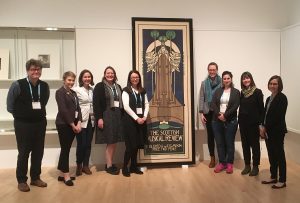
HBA Members attending CAA Study Session at LACMA, February 22, 2018. Photograph courtesy Courtney Long.
Association of Research Institutes in Art History (ARIAH)
ARIAH, a consortium of 27 institutes of advanced research in art history, has elected a new slate of officers to serve three-year terms. They include Martina Droth, Chair, Yale Center for British Art; Amelia Goerlitz, Vice-Chair, Smithsonian American Art Museum; Nan Wolverton, Secretary, American Antiquarian Society; and Cynthia Roman, Treasurer, The Lewis Walpole Library. ARIAH operates several cooperative programs in support of research and scholarly exchange in art history. The Association’s 2017 Digital Development Award for Art History Publishing was presented to Afterall and Journal 18 in support of three projects that will take advantage of new possibilities offered by digital publishing platforms for presenting art historical research. The ARIAH East Asia Fellowship Program, now in its third year, has brought eight scholars from East Asia to ARIAH member institutes for three- to four-month residencies to conduct independent research. The program is supported by The Andrew W. Mellon Foundation, The Getty Foundation, and the Terra Foundation for American Art. The Samuel H Kress Foundation is supporting an exchange program for facilitating the sharing of expertise between professional staff of ARIAH member institutions and institutions belonging to the International Association of Research Institutes in the History of Art (RIHA). In 2017, recipients included a staff member from the Yale Center for British Art (ARIAH member) who traveled to the Courtauld Institute (RIHA member), and a staff member from the Swiss Institute for Art Research at the University of Zürich (RIHA member) who worked at the Getty Research Institute (ARIAH member). ARIAH held its spring business meeting at the Getty Research Institute in conjunction with the 2018 CAA meeting in Los Angeles, and also sponsored a session entitled “Material Culture and Art History: A State of the Field(s) Panel Discussion,” chaired by Catharine Dann Roeber of the Winterthur Museum. ARIAH’s sponsored session at the 2019 CAA meeting will consider the place of artists’ residencies at the art history research institute.
Community College Professors of Art and Art History (CCPAAH)
The Community College Professors of Art and Art History had a very successful session at this year’s CAA Conference in Los Angeles. Championing the Relevancy of Studio Art and Art History in the Twenty-First Century: Stories of Success and Advocacy was chaired by Walter Meyer, Santa Monica College and Susan Altman, Middlesex County College. Thank you to all of the attendees, and presenters including Brian Seymour, Community College of Philadelphia Broadening the Appeal: Partnering with Local Collections; Shelley Drake Hawks, Middlesex Community College Art Appreciation Through A Transcendental Lens; Kathleen Wentrack, CUNY Queensborough Community College (Art History and Interdisciplinary Learning: A Model for Twenty-First Century Pedagogy; Valerie Taylor, Pasadena City College and Lisa Boutin Vitela, Cerritos College Interdisciplinary Futures: Investigating Renaissance Techniques and Art History; Justine De Young, SUNY Fashion Institute of Technology Rethinking Student Research as Public Scholarship; and Gretchen Batcheller, Cynthia Coburn and Ty Pownall, Pepperdine University Thinking Outside the White Cube: Piloting A Mobile Art Gallery in Los Angeles. All of these were interesting and thought-provoking presentations. The prospectus for next year’s conference will be posted later this spring in the CAA news and on our Facebook page, Community College Professors of Art and Art History. We welcome you to join us at next year’s conference in New York for our business meeting project share and our session, as well as our session at the FATE Conference. Please consider submitting a proposal to present at these sessions. If you want to be more involved, or have questions, please email us at: ccpaah@gmail.com
American Institute for Conservation of Historic and Artistic Works (AIC)
The most recent edition of the Journal of the American Institute for Conservation (JAIC), Vol. 56, No. 3-4, includes a variety of topics of interest to preservation professionals of all specialties, including the visual arts. The articles discuss subjects including the use of EEM Fluorescence Spectroscopy to describe natural organic colorants, the examination and analysis of Dunhuang and Turfan manuscript materials, documentation of objects using infrared and 3D imaging, and the development and testing of Incralac lacquer. Our 2018 special issue will delve into the use of reflectance hyperspectral imaging for the documentation and conservation of 2D artworks.
AIC is a membership organization supporting conservation professionals in preserving cultural heritage in different areas: architecture, book & paper, collection care, electronic media, health and safety issues, objects, paintings, photographic materials, textiles, and wooden artifacts. We produce research and publications, create educational opportunities in the field, and stimulate knowledge exchange with allied professionals. Our latest publication is Platinum and Palladium Photographs: Technical History, Connoisseurship, and Preservation, now available in our store.
One way to achieve our goal of supporting our field is through our annual meeting, where we bring together about 1,300 national and international professionals who gather to share ideas and techniques, discuss furthering the field of conservation through new initiatives, and increasing diversity. Material Matters 2018 is the theme of this year’s meeting, to be hosted in Houston, TX, May 29 through June 2, 2018. Please check out our programming for more details.
FATE (Foundations in Art: Theory and Education) News: http://www.foundations-art.org/
We had a great turnout for our Inclusion and Empathy discussion, as well as our affiliate session “Let’s Dance, But Don’t Call Me Baby: Dialogue, Empathy, and Inclusion in the Classroom and Beyond” at February’s conference in LA. A recording of our discussion will be available soon on FATE’s Positive Space podcast: http://www.foundations-art.org/positive-space-podcast
In addition, recent podcasts include: Episode 27: [ 3.28.18 ] A very honest conversation with David Janssen Jr., MFA Candidate at The University of Idaho. We unpack the privilege of being an educator, millennial haters & the urgent need to avoid becoming lazy by staying passionate about all aspects of being an academic. As a current graduate student, David offers a uniquely fresh perspective about classroom dynamics, with a focus on self reflection and empathy. Episode 26: [ 3.14.18 ] Rethinking creativity & being truly open to opportunities – even if they are unfamiliar & across the globe – marks only the beginning of our thoughtful chat with artist & educator Chris Kienke, Chair of the Foundations Curriculum at the School of Art & Design at the University of Illinois at Urbana-Champaign. Chris outlines how his evolving artistic practice has been informed by places/spaces while teaching abroad in the middle east. In addition, we discuss the state of foundations, advise for emerging educators & the navigating the politics of higher education.
Membership: Starting the 2018/2019 membership period, FATE has made changes to the Individual Membership fees including a new Adjunct Faculty Membership rate for part-time and contingent faculty members: http://www.foundations-art.org/membership
Accepting Proposals for FATE 2019, Deadline: May 18: http://www.foundations-art.org/conferences
The upcoming FATE conference, “Foundations in Flux”, hosted by Columbus College of Art & Design, will be in Columbus, OH, April 4 – 9, 2019. We are seeking proposals for panel discussions and workshop events surrounding the conference theme Foundations in Flux. As foundational learning continues to shift and grow, we educators find ourselves reinventing curricular structures to suit the needs of our first year students. We’re in a state of constant flux as we tackle new methods of technique and concept-based learning styles. At the upcoming FATE Conference, let’s dig into the ways we are engaging this new generation of global citizens — and how we can do that better.
FATE is committed to being inclusive by encouraging participation from a diverse range of voices within underrepresented identities and communities. In addition, we encourage participation from a wide spectrum within the academic community (high school educators, adjuncts, graduate students, art historians, fine artists, designers, faculty representing rural institutions, community colleges, and those teaching advanced courses).
Submit your proposals for chairing a session panel, leading a workshop, or leading a roundtable discussion & CV to FATE2019@CCAD.EDU. Please limit your topic proposals and/or workshop description to 200 words maximum. This submission deadline is Friday, May 18th, 2018.
Design History Society
The Design History Society is committed to supporting the development of research in the field of design history. The Society offers a number of annual grants and wards spread throughout the year and aimed at supporting a variety of research activities, aims and outputs. Together the grants and awards are available to a mixture of members and non-members and have been conceived to encourage innovative and inclusive definitions of design history and its methods and approaches.
DHS Conference Bursary
The Design History Society has a bursary fund to assist DHS Student members whose papers have been accepted for presentation at our annual conference. The Society endeavours to provide bursaries for up to 15 DHS student members presenting at our Conference. Each bursary includes the concessionary rate conference fee, attendance at the gala dinner. Deadline:
More information can be found at: https://www.designhistorysociety.org/awards/student-awards/dhs-conference-bursary
Design Writing Prize
Guest judge for the 2018, Johanna Agerman Ross, Curator at the Victoria & Albert Museum, and founder/director of the quarterly design journal Disegno
In order to encourage, recognise, and support writing that engages audiences in critical and contemporary issues in design writing, the Design History Society initiated a new writing prize in 2017. Running for the second time in 2018, this prize is open to scholars, researchers, critics, practitioners and educators within and outside the Society who demonstrate a commitment to furthering the work of critical debate in design through writing. The aim of the Design Writing Prize, in addition to promoting and celebrating excellent new work, is to advocate writing as a necessary and creative practice for communicating ideas related to design. In this vein, entries that include a variety of modes such as essays, interviews, reviews or editorial commentary are welcome and can either be published works or in manuscript phase. Deadline: 16.00 GMT on 15 June 2018
More information can be found at: https://www.designhistorysociety.org/awards/design-writing-prize
Student Essay Prize
Submissions are invited for the Design History Society Essay Prize, established in 1997 in order to maintain high standards in design history in higher education. Two essay prizes are awarded annually; one to an undergraduate student and the other to a postgraduate (MA or PhD). Deadline: 16.00 GMT on 15 June 2018.
More information can be found at: https://www.designhistorysociety.org/awards/student-awards/essay-prize
Research Travel & Conference Grant
The Research Travel and Conference Grant is awarded by the DHS annually to assist those need to travel to conduct essential research for their design history scholarship or to present new research at key academic conferences. Deadline: 15th May
More information can be found at: https://www.designhistorysociety.org/awards/research-grants/travel-grant
Strategic Research Grant
The Strategic Research Grant expresses the Society’s work to lead the academic commitment to design history research. Founded in 2012 to encourage design history research in non-Western geographies and post-colonial perspectives, as of 2015 the Strategic Research Grant is an annual award. The Grant supports original and significant research in non-Western, post-colonial and other areas, themes and methods that have either been overlooked or underrepresented in the field but are important to its future development. Applicants must be engaged in research leading to a conference paper or published outcome such as a peer-review journal or other academic publication. Deadline: 15th November
More information can be found at: https://www.designhistorysociety.org/awards/research-grants/strategic-travel-award
Research Exhibition Grant
The Research Exhibition Grant is awarded by the DHS annually to assist those engaged in design history research that leads to an exhibition or display. The exhibition or display may be permanent or temporary, and take a physical and/or digital format. Deadline: 15th March
More information can be found at: https://www.designhistorysociety.org/awards/research-grants/exhibition-grant
Research Publication Grant
The Research Publication Grant is awarded by the DHS annually to assist those engaged in design history research with the publication of their research in research-based outputs such as peer-reviewed journal articles or books published by an academic press or museum institution. Deadline: 15th January
More information can be found at: https://www.designhistorysociety.org/awards/research-grants/publishing-grant-1
Student Travel Award
The Student Travel Award is awarded by the DHS annually to encourage and support research activity amongst students in the field of design history. The grant is open to all student members of the society. To be eligible to apply, applicants must be currently enrolled as undergraduate or postgraduate student at any institution and undertaking research in the field of design history of any geography and period.
The Student Travel Award may be used towards the costs incurred for research trips including travel to conferences, accommodation, travel and other research expenses (e.g. photocopying costs, library membership). Deadline: 15th January
More information can be found at: https://www.designhistorysociety.org/awards/student-awards/student-award
Day Symposium Grant
The DHS Day Symposium Grant assists DHS members convene a symposium to discuss and disseminate design history research. The Grant is part of the Society’s aim to promote and support scholarship in the field of design history and to play a role in shaping an inclusive and innovative field. The DHS Day Symposium Grant aims to support high quality, original research activity. No fixed deadline
More information can be found at: https://www.designhistorysociety.org/awards/day-symposium-grant
Outreach and Events Grant
he DHS Outreach Event Grant provides assistance for DHS members to convene a public event to promote design history beyond a traditional academic setting. This Grant is part of the Society’s aim to promote the field of design history and to play a role in shaping inclusive and innovative forums, support activities that offer new perspectives on how design history can engage diverse audiences and contribute to public discourse that reaches wider communities. No fixed deadline
More information can be found at: https://www.designhistorysociety.org/awards/dhs-outreach-and-events-grant
Association for Textual Scholarship (ATSAH)
Members’ Publications
Eliana Carrra, “Un proposito di identificazione per il Ritratto di giovane con libro di Agnolo Bronzino: Benedetto Bsini,” Annali di Critic d’Arte N. 1 (2017):89-115.
Deborah Cibelli, Review of The Early Modern Child in Art and History, edited by Matthew Knox Averette, The Sixteenth Century Journal, XLVII (2016):783-85.
Jennifer Bates Ehlert, “Hylas and the Matinee Girl: John William Waterhouse and the Female Gaze,” Athanor, Vol. 36 (June 2018): 69-76.
Sara N. James, “Wit and Humor in Ugolinodi Prete Ilario’s Life of the Virgin at Orvieto,” Source: Notes in the History of Art vol 36, no.3-4 (Spring/Summer2017):159-67.
Sara N. James, “Review of Tarnya Cooper, Aviva Bunstock, Maurice Howard, and Edward Town, eds. Paintingin Britain 1500-1630: Production, Influences, and Patronage. A British Academy Publication. Oxford, Oxford University Press, 2016, for the Sixteenth Century Journal, XLVIII/1 (Spring2017):249-51.
Robin O’Bryan, “Carnal Desire and Conflicted Sexual Identity in a ‘Dominican’ Chapel” In Images of Sex and Desire in Renaissance Thought and Modern Historiography ed. Angeliki Pollali and Berthold Hub (Routledge, 2017), 40-68.
Robin O’Bryan, “Michelangelo’s Sistine Dwarf”
Source: Notes in the History of Art 36, no. 2 (Winter 2017): 67-77.
Emilie Passignat, ‘’Manière’, ‘maniéré’, ‘maniériste’ : transferts et enjeux théoriques autour d’un terme clé du vocabulaire artistique », in Michèle-Caroline Heck (ed.), Lexicographie artistique : formes, usages et enjeux dans l’Europe moderne (Montpellier, PULM, 2018), 363-376, on-line, doi: 10.26530/OAPEN_644313 .
Emilie Passignat, “Manière”, in Michèle-Caroline Heck (ed.), Lexart. Les mots de la peinture (France, Allemagne, Angleterre, Pays-Bas, 1600-1750) (Montpellier, PULM, 2018), 333-339.
Emilie Passignat,“Maniéré”, in Michèle-Caroline Heck (ed.), Lexart. Les mots de la peinture (France, Allemagne, Angleterre, Pays-Bas, 1600-1750) (Montpellier, PULM, 2018), 340-343.
Liana De Girolami Cheney, “Camillo Camilli’s Imprese for the Academies,” Journal of Literature and Art, Vol. 8 No. 4 (April 2018):598-613
Liana De Girolami Cheney, “Jan Haicksz Steen’s Woman at Her Toilet: “Provocative Innuendos,” Journal of Literature and Art Studies Vol. 7, No. 10, (October 2017): 1-11, doi: 10.17265/2159-5836/2017.10.000
Liana De Girolami Cheney, “Giovanni Antonio Bazzi, Allegories of Love: Emblematic Ardor,” Cultural and Religious Studies, Vol. 5, No. 5, (May 2017): 1-37, doi: 10.17265/2328-2177/2017.05.000
Pacific Arts Association
The Pacific in Europe, Europe and the Pacific Linden-Museum Stuttgart | 26–28 April 2018
The annual PAA-E meeting entitled “The Pacific in Europe, Europe and the Pacific” will be held at the Linden-Museum Stuttgart, State Museum of Ethnology, from 26 until 28 April 2018 to coincide with the exhibition Hawai‘i – Royal Islands in the Pacific (14 October 2017 – 13 May 2018).
The Pacific Arts Association’s XIII International Symposium will be held in Brisbane 25-28 March 2019.
The Pacific Chapter has decided to create a pre-symposium opportunity to visit and learn about the arts of Vanuatu whilst they plan and refine their travel arrangements for next year.
As well as participating in panel discussions about key issues relating to the arts of the Pacific, the Vanuatu conference will be a chance to visit Port Vila, engage with kastom, meet local artists and cultural workers, and experience town and the contemporary arts scene.
In the meantime, if this piques your interest, please contact Karen Stevenson on ks-kf@xtra.co.nz so that she can get a sense of numbers as she and colleagues continue to plan for this.
Association of Historians of American Art
CALL FOR PAPERS
The Association of Historians of American Art Fifth Biennial Symposium
October 4-6, 2018
Minneapolis-St. Paul, Minnesota
AHAA invites proposals for presentations on any aspect of North American art, visual/material culture, and architectural history, broadly construed. We encourage a broad range of proposals, reflecting a diversity of both topics and methodological approaches. Please send: (1) a 250-word abstract, (2) a proposed title, (3) a clear indication of presentation format, and (4) a short c.v. of no more than two pages by Friday, April 13, 2018 to Robert Cozzolino, Jennifer Marshall, and Christina Michelon, AHAA Symposium co-chairs at: ahaa.twincities@gmail.com. Inquiries may also be directed to that email address. http://www.ahaaonline.org/page/2018SymposiumCFP
CALL FOR PAPERS
AHAA sponsored session at CAA
February 13-16, 2019
New York, NY
As an affiliated society of CAA, the Association of Historians of American Art (AHAA) sponsors a session at CAA’s Annual Conference. This year, AHAA is seeking proposals for a one-and-a-half-hour professional session addressing any of the following: new pedagogies, exhibitions, patronage, auctions, and publishing. Please submit a title and short description of the session, along with the proposer’s c.v. and a statement of expertise on the topic proposed to sessions@ahaaonline.org by April 13, 2018.
SECAC
SECAC awards two $5,000 prizes annually: The Artist’s Fellowship, awarded to an individual artist or to a group of artists working together on a specific project, and the William R. Levin Award for Research in the History of Art, an award of an annual total of $5,000 to one or more art historians who are members of the organization. The Artist’s Fellowship entries must be submitted by August 14, 2018; the Levin Award entries must be submitted by August 31, 2018. For more information see: http://www.secacart.org/artists-fellowship and http://www.secacart.org/research-in-art-history.
The 74th Annual SECAC Conference, hosted by the University of Alabama at Birmingham, will be held in Birmingham, Alabama, October 17 through 20, 2018. Events during the conference will include a keynote address by Andrew Freear, Director of Auburn University’s Rural Studio. Freear is a recent Loeb Fellow at Harvard University Graduate School of Design and has designed and built Rural Studio exhibits across the globe including at the Whitney Biennial, the Sao Paulo Biennal, the V&A in London, MoMA NYC, and most recently, the Milan Triennale and the Venice Biennale. A SECAC-only private reception to view the exhibition, Third Space/Shifting Conversations about Contemporary Art will be held at the Birmingham Museum of Art, and the annual SECAC Artist’s Fellowship and Juried [Members] Exhibitions will be on view at UAB’s Abroms-Engel Institute for the Visual Arts. Designed by the world-renowned architect, the late Randall Stout, AEIVA is a center for UAB and the Birmingham community to engage with contemporary art and artists. The 2018 Members Exhibition will be juried by Peter Baldaia, Head of Curatorial Affairs, Huntsville Museum of Art. For more information see: http://www.secacart.org/conference.
Juried Exhibition submission deadline, April 15, 2018: https://secac.secure-platform.com/a/solicitations/home/3
Call for Papers deadline, April 20, 2018: https://secac.secure-platform.com/a/solicitations/home/2
Arts Council of the African Studies Association (ACASA)
This activity report pertains to events held by the Arts Council of the African Studies Association during the 2018 CAA Annual Conference at UCLA.
ACASA held one sponsored panel during the CAA Annual Conference. Titled “Abstraction in Africa: Origins, Meaning, Function” it was organized by Kevin Tervala, a Ph.D. candidate at Harvard University. A session that solicited contributors, it eventually included the following presentations:
- “Abstraction, Extraction, and Transaction in the Carved Doors of Zanzibar”
Janet Purdy, The Pennsylvania State University - “Between Abstraction and Figuration: Corporeal Excess and Uncertainty in Nineteenth-Century Zulu Vessels”
Theresa Sims, University of Illinois at Urbana–Champaign - “Abstraction and Mobility in Northwestern Kenya ”
Kevin Tervala, Harvard University
In addition to the ACASA-sponsored panel, ACASA organized a special event at the Fowler Museum at UCLA in the form of an Open House. The museum offered coffee, tours, and conversations about the exhibitions on view to ACASA members and CAA annual meeting participants: the Fowler’s PST show, Axe Bahia: The Power of Art in an Afro-Brazilian Metropolis, and Bread, Butter, and Power: Paintings by Meleko Mokgosi. It was a great opportunity to visit the museum and mingle with colleagues.
Historians of German, Scandinavian, and Central European Art & Architecture (HGSCEA)
HGSCEA organized another successful set of events at CAA this year in Los Angeles.
The well-attended sponsored session was chaired by Allison Morehead, and examined critical race theory in Scandinavian, Central European, and German art. It comprised four papers: Rebecca Houze considered constructions of ethnicity and national identity in Hungarian design, Pat Berman examined the discourse of whiteness in Norwegian art, Bart Pushaw drew attention to several cases of the representation and repression of race in Scandinavian art, and Kristin Schroeder analyzed the depiction of race and gender in a painting by Christian Schad. HGSCEA was also well represented at the conference more generally. Members presented their research in other sessions, acted as chairs and commentators, and represented organizations and journals. The participation of two early-career scholars, Tomasz Grusiecki and Max Koss, was supported by HGSCEA Travel Stipends.
The annual reception, a catered Mexican dinner at a studio space near the convention center, was attended by about forty members. They saw old friends, made new acquaintances, and learned the results of the 2017 Emerging Scholars Prize. From a large pool of strong submissions, the Board named two articles published last year as the winners: Tomasz Grusiecki, “Foreign as Native: Baltic Amber in Florence,” and Kerry Greaves, “Thirteen Artists in a Tent: Danish Avant-garde Exhibition Practice during World War II.” Morgan Ng received an Honorable Mention for “Toward a Cultural Ecology of Architectural Glass in Early Modern Northern Europe.”
During the business meeting, the Board not only heard reports from the president, treasurer, and website manager, but also discussed the proposals it had received for next year’s session at CAA in New York. All were appealing, but the Board selected the one sent by Kerry Greaves, “Women Artists in Germany, Central Europe, and Scandinavia, 1880-1955.”
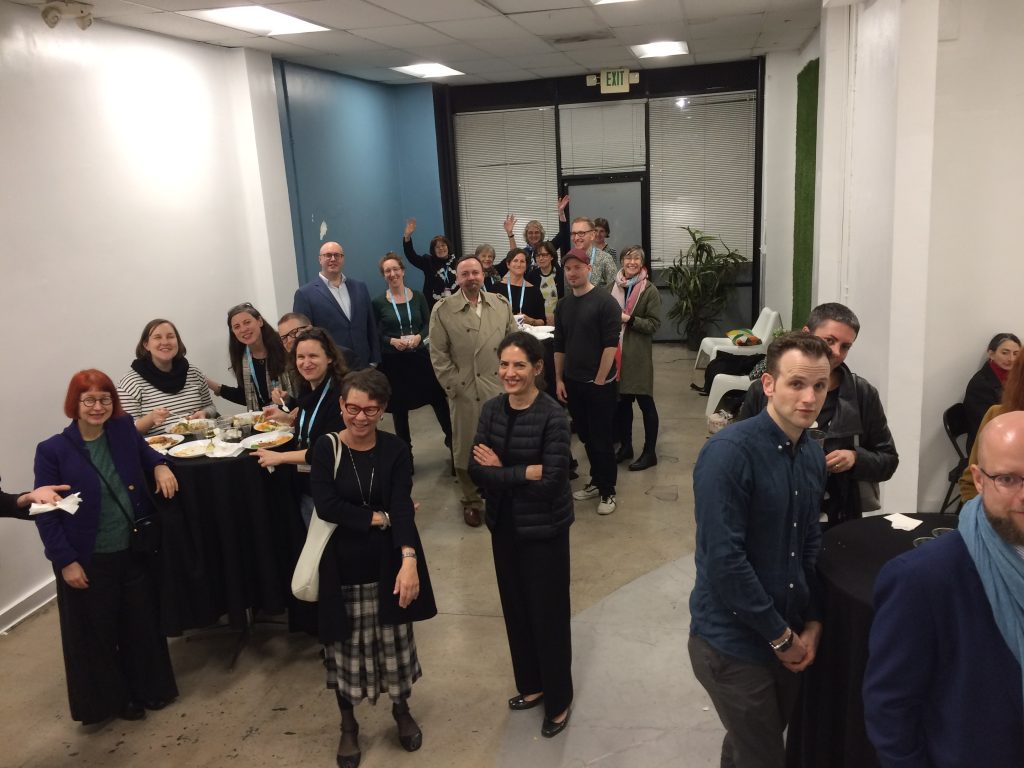
HGSCEA at the CAA Annual Conference in Los Angeles, 2018.
American Society of Hispanic Art Historical Studies (ASHAHS)
The American Society of Hispanic Art Historical Studies (ASHAHS) announced the results of the Eleanor Tufts Award at its business meeting at the 2018 annual conference of the College Art Association. The annual award, established in 1992 to honor Professor Tufts’ contributions to the study of Spanish art, recognizes an outstanding English-language book in the area of Spanish or Portuguese art history. This year the committee chose to give the Eleanor Tufts Award to Oscar E. Vázquez, The End Again: Degeneration and Visual Culture in Modern Spain (University Park, PA: Penn State University Press, 2017). In addition, the jurors selected two books for honorable mention: Ilona Katzew, et al., Painted in Mexico, 1700-1790: Pinxit Mexici (Los Angeles, CA: Los Angeles County Museum of Art; Mexico City: Fomento Cultural Banamex, A.C.; New York, NY: DelMonico Books/Prestel, 2017) and Amanda Wunder, Baroque Seville: Sacred Art in a Century of Crisis (University Park, PA: Penn State University Press, 2017).
Association of Historians of American Art (AHAA)
Preparations are underway for AHAA’s Fifth Biennial Symposium, October 4-6, 2018 in Minneapolis and St. Paul, Minnesota. The goal of this biennial symposium is to represent the most innovative, creative, and rigorous scholarship currently shaping the field of American art. http://www.ahaaonline.org/
The Executive Editors of Panorama: Journal of the Association of Historians of American Art are pleased to announce that The Henry Luce Foundation has awarded the journal a three-year, $45,000 grant to support publication of the journal. This grant supports the position of managing editor, provides professional development in art history and digital humanities, and funds subventions to help authors defray the cost of image reproduction fees.
“The Henry Luce Foundation has been a strong supporter of Panorama since its inception, and we are delighted to announce funding that ensures our financial base through 2020,” said Betsy Boone, an Executive Editor for the journal. “Luce funding has allowed us to professionalize our administrative structure, allowing us to bring cutting-edge scholarship on American art to audiences around the world through our open-access platform.”
The International Art Market Studies Association (TIAMSA)
TIAMSA is offering the following events over the upcoming months:
1) Porto Alegre, Brazil, April 8-10 – ART BEYOND ART: First Symposium on Art Systemic Relations (Goethe Institut, Porto Alegre) – From production to access, the world of visual arts have changed substantially in the last decades, especially considering the performances of agents and institutions which together act in the creation of legitimating structures and in the definition of what art is or is not. However, the logic of production, circulation, legitimization and consumption is also associated with spheres other than those specific to the art world, highlighting the connections inherent in the development of the greater art system. In this sense ART BEYOND ART, the first Symposium on Art Systemic Relations, proposes to debate the transformations in the mode(s) of operation and in the production of contemporary visual art. Essentially transdisciplinary, the event aims to open the dialogue between researchers of Arts, Sociology, Anthropology, Philosophy, Literature, Technology, Sciences and other areas. – This conference is an initiative of TIAMSA Art Market and Collecting – Portugal, Spain and Brazil (TIAMSA AMC_PSB). All further information can be found in the related post and on the Conference Website.
2) TIAMSA’s 2nd Conference will take place in September in Vienna: ART FOR THE PEOPLE? Questioning the Democratization of the Art Market.
2nd Conference
TIAMSA – The International Art Market Studies Association
Vienna, 27-29 September 2018
Apply by April 15, 2018
The art world and the market have traditionally been the domain of the elites and have thrived on exclusivity. However, the art world has arguably become much more democratic in recent years thanks to the digital revolution, the inclusion of emerging economies in the world art market system, and the vastly improved access to art and information. The price histories of works of art can nowadays easily be reconstructed using online databases; the threshold for art buying is significantly lowered by online sales platforms; and new buyers in emerging economies are making the art market much less Western-oriented. Moreover, an ever broader range of artworks in different price categories has put (fine) art within reach of the middle classes across the globe. At the same time, art institutions such as museums are under tremendous pressure to be less exclusive. Some of these democratizing tendencies are of course not new. For instance, publishing houses in Europe started disseminating prints on a massive scale already in the sixteenth century, thereby enabling larger segments of the population to acquire images. Read more here
TIAMSA members receive discounts to our events as well as Art Market Studies related publications from BRILL, Francis & Taylor, Brepols / Harvey Miller.
For more information go to https://www.artmarketstudies.org
Society of Architectural Historians (SAH)
The Society of Architectural Historians is now accepting abstracts for its 72nd Annual International Conference in Providence, Rhode Island, April 24–28. Please submit an abstract no later than 11:59 p.m. CDT on June 5, 2018, to one of the 34 thematic sessions, the Graduate Student Lightning Talks or the Open Sessions. SAH encourages submissions from architectural, landscape, and urban historians; museum curators; preservationists; independent scholars; architects; scholars in related fields; and members of SAH chapters and partner organizations. The thematic sessions have been selected to cover topics across all time periods and architectural styles. If your research topic is not a good fit for one of the thematic sessions, please submit your abstract to the Open Sessions. View the full Call for Papers at www.sah.org/2019.
SAH is now accepting applications for the 2018 SAH/Mellon Author Awards. Funded by a grant from The Andrew W. Mellon Foundation and administered by SAH, the award is designed to provide financial relief to scholars who are publishing their first monograph on the history of the built environment. The purpose of the award is to help defray the high costs of image licensing, reproductions and creation of original drawings and maps for monographs on the history of the built environment. The application deadline is May 31, 2018.
SAH has partnered with the Global Architectural History Teaching Collaborative (GAHTC) to offer Research-to-Teaching Grants and Field Seminar Travel Grants. These new grants are part of the GAHTC’s nearly $500,000 in funding to build new content for its free, digital platform of teaching materials. Learn more at gahtc.org/grants.
International Association for Word and Image Studies (Association Internationale pour l’étude des Rapports entre Texte et Image) (IAWIS/IAERTI)
Call for Participation for 2018 Conference of the International Society for Intermedial Studies
Intermedial Practice and Theory in Comparison
Hangzhou, China, 15-17 November 2018
With the ever-growing proliferation of electronic and other popular media in the more and more networked and “mediatised society,” the diversity and complexity of cultural reproduction and social reconstruction through media underscores now, more than ever, the need to expand Intermedia Studies by incorporating a “planetary” comparative perspective and encouraging voices from subaltern cultures. In recent years, Asian artists like CAI Guoqiang, the “Master of Gunpowder,” have gained international prominence in the intermedia world, and their intermedial practices were often executed and exhibited in various cultural epicentres, e.g., Beijing or New York. However active and interactive such practices are and however broad the audience is, a critical survey of the intermedia theory in cultural comparison is largely missing in previous discussions. We all use media and all media are related, but we might not view media in the same way. Therefore, this conference aims at fostering an interdisciplinary and intercultural conversation on intermedia between scholars, artists and theorists from all domains.
We are seeking panel, paper and round-table contributions that address the theme of the conference: revisiting intermedial practice and theory from a comparative perspective (e.g., past/present, East/West, etc.) to see how artistic, cultural and social practices differ from and interact with each other and how theories evolve in these media constellations locally and globally. We invite proposals for 10- or 20-minute presentations on a broad variety of topics and methodological approaches from disciplines including (but not limited to) Media Studies, Literary Studies, Cultural Studies, Critical Theory, Philosophy, Art History, Visual Arts, Musicology, Theatre and Performance Studies, Rhetoric, Gender and Sexuality Studies, Architecture and Design, Communication, Politics, Religious Studies, and Sociology.
Proposals for papers, pre-constituted panels, or round tables can be submitted by emailing the submission form (downloadable on http://wgyxy.hznu.edu.cn/ISIS2018) as an attachment to SFL@hznu.edu.cn with the subject line “Proposal ISIS2018”. Deadline for submissions is June 15, 2018, and acceptances will be notified by July 15,2018.
Please note that the working language of the conference is English.
Art Libraries Society of North America (ARLIS/NA)
- ARLIS/NA session at CAA in Los Angeles in February
Teams composed of art and design faculty and librarians presented their experiences collaborating with students in the library in a successful session on February 22nd entitled “Engaging the iterative: pedagogical experiments across art and design disciplines.” Chaired by Jennifer Martinez Wormser of the Laguna College of Art + Design; Emilee Mathews, form the University of California, Irvine, the individual presentations included:
COLORientation: Visualizing Color Systems
Xun Chi, Laguna College of Art + Design; Jennifer Martinez Wormser , Laguna College of Art + Design
The Intersection of Influence: Co-teaching the Undergraduate and Graduate Architecture Degree Project and Thesis Preparation Courses
Cathryn Copper, Woodbury University School of Architecture
Engaging the Art World in the Classroom
Bridget R. Cooks, University of California, Irvine; Emilee Mathews, University of California, Irvine
Collaborating, Learning, and Exhibiting
Parme Giuntini, Otis College of Art and Design; Kerri Steinberg, Otis College of Art and Design; Sue Maberry, Otis College of Art and Design
- Awards announced at ARLIS/NA annual conference in New York in February:
The Art Libraries Society of North America (ARLIS/NA) is pleased to announce Kathryn Wayne as the recipient of the 2017 Distinguished Service Award. She is the 27th person to receive the Society’s highest honor. The Distinguished Service Award honors an individual whose exemplary service in art librarianship, visual resources curatorship, or a related field has made an outstanding national or international contribution to art information. Kathryn’s deep and far-reaching contributions to the Society and to the field of art librarianship perfectly embody the accomplishments most valued by the Society.
Kathryn recently retired as head of the Art History/Classics Library at the University of California, Berkeley. She came to UC Berkeley in 1990 as Architecture and Landscape Architecture Librarian at Berkeley’s Environmental Design Library following many years as Architecture Librarian at the University of Arizona.
Two of her notable publications are the seminal reference book Architecture Sourcebook: A Guide to Resources on the Practice of Architecture published by Omnigraphics in 1997, and her contribution to the 33-volume Encyclopedia of Library and Information Sciences published by CRC Press in 2010, for which she wrote the chapter on Art Librarianship.
Despite these impressive professional accomplishments, Kathryn never lost sight of the fundamental role of librarianship at her home institutions. Her dedication to students endured throughout her career. She established an information literacy program at the University of California, Berkeley School of Environmental Design and shared her experience through a subsequent professional presentation on the program. She mentored San Jose State library school students and University of California undergraduate students. One former student wrote, “Kathryn has not only enriched the profession, she has shaped my life.”
The Art Libraries Society of North America (ARLIS/NA) is pleased to announce that the exhibition catalogue for Radical Women: Latin
American Art, 19601985 curated by Cecilia Fajardo Hill and Andrea Giunta, has been awarded the 39th annual George Wittenborn Memorial
Book Award, announced at the ARLIS/NA annual conference in New York in February.
The Art Libraries Society of North America (ARLIS/NA) is pleased to announce that Desire Change: Contemporary Feminist Art in Canada, edited by Heather Davis and co-published in 2017 by McGill-Queens University Press and Mentoring Artists for Women’s Art (MAWA), has been awarded the 27th annual Melva J. Dwyer Award.
Design Incubation
Call for Entries: Communication Design Educators Awards Competition
Design Incubation is accepting entries for the 2018 Educators Awards until May 31, 2018. This international academic awards competition has 4 categories:
• Scholarship: Published Research
• Scholarship: Creative Work (design research, creative production, and/or professional practice)
• Teaching
• Service (departmental, institutional, community)
We are excited to announce an international jury of distinguished design academics.
Jorge Meza Aguilar
Professor of Strategic Design
Provost for Outreach and Collaboration
Universidad Iberoamericana
Mexico City, Mexico
Ruki Ravikumar
Director of Education
Cooper Hewitt, Smithsonian Design Museum
New York, NY
Wendy Siuyi Wong
Professor, Graduate Program Director
Department of Design
York University
Toronto, Canada
Steven McCarthy
Professor of Graphic Design
University of Minnesota
Maria Rogal
Professor of Graphic Design
University of Florida
Use this form to submit your entry online.
For further details, visit the Competition Overview page.

Online form: https://designincubation.com/award-competition-entry/
Call for Entry: https://designincubation.com/call-for-submissions/call-for-entries-communication-design-educators-awards-2018/
Awards overview: https://designincubation.com/educators-awards/
Conference Submissions for CAA 2019
posted by CAA — Feb 27, 2018
CAA 2019 Annual Conference
February 13-16, 2019
New York, NY
Hilton Midtown
Beginning March 1, 2018, CAA members are invited to submit the following proposals for review to the 2019 CAA Annual Conference Committee: Complete Sessions, Sessions Soliciting Contributors, and Individual Paper/Project proposals. Submissions that cover the breadth of current thought and research in art and art practice, art and architectural history, theory and criticism, studio art, pedagogical issues, museum and curatorial practice, conservation, design, new media, and developments in technology are encouraged.
The submissions portal closed on April 27, 2018.
PROPOSAL SUBMISSION TYPES
Complete Session
The organizer has complete information about the session including names and affiliations of all session participants, presentation titles, abstract texts, etc.
Session Soliciting Contributors
The organizer proposes a session title and abstract that will require a call for participation. The list of accepted Sessions Soliciting Contributors will be posted on the CAA website in late June or early July, 2018. Session organizers select papers and projects based on their own requirements. See CAA 2019 Call for Participation section below for more information.
Individual Paper/Project
An individual CAA member may submit an abstract (with title), which, if accepted, will be included in the 2019 conference as part of a composed session with others accepted in this category based on subject area or compatible content.
OPENS: March 1, 2018
DEADLINE: April 27, 2018 [closed]
Please note: To submit a proposal, individuals must be current CAA members. All session participants, including presenters, chairs, moderators, and discussants, must also be current individual CAA members. Please have your CAA Member ID handy as well as the member IDs of any and all participants as this is a required field on the submission form. Please note that institutional member IDs cannot be used to submit proposals. If you are not a current individual member, please renew your membership or join CAA.
The Annual Conference Committee members review over 800 submissions each year. They take into account subject areas and themes that arise from accepted proposals to present as a broad and diverse a program as possible. The Committee selects between 250-300 sessions for each conference and it must, at times, make difficult decisions on submissions of high merit.
CAA schedules the conference program so that there are back-to-back sessions with similar content. However, given the number of sessions, this is not always possible. All sessions are 90 minutes in length and are scheduled Wednesday, February 13, through Saturday, February 16, in the following timeslots:
- 8:30—10:00 AM
- 10:30 AM—12:00 PM
- 2:00—3:30 PM
- 4:00—5:30 PM
- 6:00—7:30 (Thursday, February 14, and Friday, February 15, only)
CAA AFFILIATED SOCIEITES AND CAA COMMITTEES
CAA Affiliated Societies and CAA Committees may each submit for one guaranteed session in the Complete Session or Session Soliciting Contributors category according to the general session proposal deadlines. Visit Affiliated Society membership for more information on participating in the CAA Annual Conference.
GENERAL PROPOSAL SUBMISSION INFORMATION
- Session and paper/project abstracts should be no more than 250 words in length.
- Please follow the Chicago Manual of Style for your submission.
- The accuracy of information in the submission is important as, if selected, it will be transferred to the conference program, abstracts booklet, website, etc., exactly as written.
KEY DATES
- March 1 – April 27: Call for Proposals (includes Complete Session, Session Soliciting Contributors, Individual Paper/Project)
- Early July: Notifications sent to all submitters
- July: Call for Participation for accepted Sessions Soliciting Contributors posted on CAA website
- End July: Notifications sent to accepted individual paper/project participants regarding composed session configurations
- Late August: Organizers of Sessions Soliciting Contributors finalize session information and notify accepted contributors
- September 4: Deadline for updated accepted session content entered into portal by original submitter for all categories for print and web publications (includes any required edits to abstracts, titles, and speaker order)
- mid-September: CAA 2019 Annual Conference schedule finalized
- October 8: CAA 2019 Annual Conference schedule posted on CAA website; online conference registration opens
- December 16: Early conference registration closes
- December 17: Advance conference registration opens
- February 8: Advance conference registration closes
FORTHCOMING CALLS FOR SUBMISSIONS
Poster Session
OPENS: May 21, 2018
DEADLINE: August 15, 2018
CAA invites proposal submissions for Poster Sessions at the CAA 2019 Annual Conference. Poster Sessions offer excellent opportunities for informal discussion and conversation focused on topics of scholarly or pedagogical research. Proposals require a description of the project (up to 250 words), with a title and member CV.
Exhibitor Session
OPENS: May 23, 2018
DEADLINE: September 14, 2018
Registered exhibitor at the 2019 conference are welcome to propose full sessions or workshops (ninety minutes in length) for inclusion in the full-conference program. These sessions should convey practical information, professional expertise, or historical/scholarly content and may not be used for direct marketing, sales or promotion of products, publications, or services or programs.
Call for Participation for accepted Sessions Soliciting Contributors
The CAA 2019 Call for Participation (CFP) for accepted Sessions Soliciting Contributors will be posted on the CAA Annual Conference website on June 29, 2018. Submissions will be accepted for review through August 6, 2018.
Beginning June 29th, 2018, single paper or project submissions in response to the CFP should be sent directly to the session chair(s)—if there is more than one session chair, send materials to both chairs. Proposals should include a proposal form (found at the end of the CFP), an abstract of your presentation, a cover letter to chair(s), a shortened CV, and work documentation (if necessary).
FREQUENTLY ASKED QUESTIONS
Q: Do I have to be a CAA member to submit a proposal?
A: All conference participants (presenters, chairs, discussants) must be CAA members to participate in the annual conference. A CAA member ID number will be requested for all conference participants in the online submission form. However, if you do not have all CAA ID numbers available for participants, you may enter them when you obtain them. If you are not a member of CAA at the time you submit the proposal, you will not be prevented from submitting. You may work on the submission in stages until the proposal deadline.
Q: Is CAA membership required to participate on a CAA session?
A: Yes, ALL session participants (presenters, chairs, discussants) must be members of CAA in order to participate in vetted conference sessions.
Q: Is CAA membership required to participate on an Affiliated Society guaranteed session?
A: Yes, all session participants (presenters, chairs, discussants) must be members of CAA in order to participate in guaranteed Affiliated Society sessions.
Q: Can someone who is not a CAA member participate in a panel?
A: We require all conference session participants to be CAA individual members.
Q: How long is a session?
A: All CAA 2019 sessions are ninety minutes in length. Please plan either session or paper/project presentations accordingly.
Q: How many people should be on a panel?
A: For a traditional ninety-minute session, we suggest one chair, four participants, and one discussant. This format allows introductions, fifteen-minute presentations, and Q&A. CAA encourages innovative session formats but all session participants must plan accordingly.
Q: How many ways can I participate in conference sessions?
A: To allow a greater number of CAA members to participate in the conference, CAA members can participate in the following roles only once during a conference: chair, presenter, discussant. They can serve in all three roles, but cannot perform any of these roles more than once. For example, they can serve as chair and present in one session, and serve as discussant at another session, but cannot present twice.
Q: Can I attend the session for free if I am presenting on that session?
A: While you cannot attend a session for free, even for the one you are presenting in, we do offer a number of conference registration options including full registration, day passes, and single session time slot tickets.
Q: Can I plan something other than a traditional panel?
A: YES! Feedback from our attendees reveals that they want to take in information and learn in formats other than several people sitting at table in front of a session room. They very much want more interaction with panel participants. We strongly encourage you to think about presenting your content in a manner other than the traditional panel format. While planning your session, you are reminded that we cannot deviate from the ninety-minute time limitation.
Q: Can I have a two-part session?
A: The Annual Conference Committee aims to include as many contributors as possible reflecting the range of scholarship and expertise. In the submission process, please make the request and the committee will evaluate this based on the number of subject areas received as well as the logistical possibilities.
Q: If I am selected to participate as an individual paper/project participant how is my session arranged?
A: Accepted individual paper/projects are organized by the Annual Conference Committee and the CAA staff into what is called Composed Sessions with other individual paper/projects based on subject area or compatible content. Since there is no formal chair for Composed Sessions a mentor is assigned to the group to provide guidance as needed. Sometimes participants identify one in the group to act as chair, sometimes a CAA member outside the group is asked to lead, other groups choose to go without this formal role.
Q: Are there sessions that are free and open to the public?
A: The mid-day time slot (12:30 – 1:30 PM) is free and open to the public. This time slot is reserved for business meetings and special conversations on hot topics for the field. There are other events throughout the conference which are also free. Check the schedule when it is posted in October for details. Please remember to check back often as the schedule is updated as the conference approaches.
For more information about session proposals for the 2019 Annual Conference, please contact Mira Friedlaender, CAA manager of programs, at 212-392-4405 or Tiffany Dugan, CAA director of programs and publications, at 212-392-4410.
Introducing the New CAA
posted by CAA — Feb 27, 2018
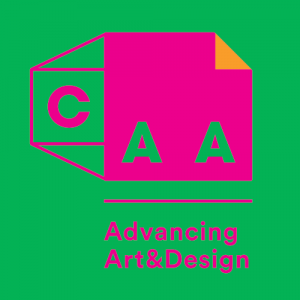
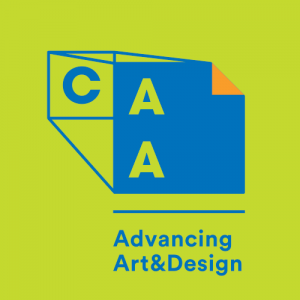
A New Look for CAA
As we look to build CAA in the future, with new and energized staff, new programs that will assist all of us in our professional lives, we have given the organization a new look and a name more focused on how our members know us after many years of service. We unveiled our new logo, new name, and new branding colors at the 106th Annual Conference last week in Los Angeles.
For decades, people have used the term “CAA” as a nickname for the Association. Many of our members feel connected to the words, College Art Association, but many others, especially new members and prospective members, feel these words don’t resonate with them. We started the renaming and rebranding process in spring of 2017 with the retention of a professional design and branding firm called Briteweb, which works exclusively with social sector organizations. This fall, as part of the research process, CAA and Briteweb held workshops, surveyed the current and past membership, and conducted interviews with long-standing and new members, as well as other arts professionals.
Nearly 1,500 members and members of the wider CAA community contributed to surveys and questionnaires about a new name and mark for the organization. As part of the process, we not only looked internally at our own membership but also at the marks of similar societies and organizations. To shepherd the process, CAA established a Branding Subcommittee, which reviewed and synthesized all of the ideas coming from membership and from Briteweb.
Last December we reached the first major milestone in the renaming and rebranding process. The Board, informed by member feedback, unanimously voted to simply call the organization CAA and to add a tagline ADVANCING ART & DESIGN to be used in coordination with the three letters.
Then we built a new logo. We built the new logo by thinking about the field, about our collective passions and interests, and the work we work we do every day. We narrowed down to two core components: the frame and the page. We used these symbols of the lives and work of our members as the building blocks of the new visual identity. They represent what we study, what we teach, what we practice, and what we create. We spend endless hours looking at, thinking about, writing about and reading about art.
We also wanted the idea of flexibility to be part of CAA’s new identity so we’ve adopted a logo system that can change as we do and as the field does. And the color palette was, of course, very important to us. We wanted to inject vibrancy and lots of color into our new logo system.
But change is more than a logo. This is about a shift in how we work to assist everyone in the field. A new look necessitates action. This is about more opportunities to present papers at the conference. This is about more opportunities to publish articles. It’s about more opportunities to network with colleagues. It’s about more opportunities to advocate for the field. It’s about beginning to think seriously about attracting otherwise marginalized communities to be part of the field.
This is the future of CAA.
A Brief History of 107 Years of Branding at CAA
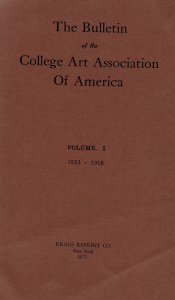
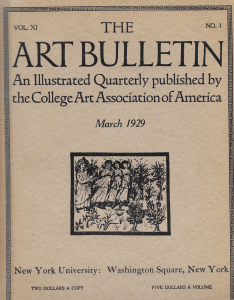
From its inception, the College Art Association understood the importance of its name. Publications like The Art Bulletin (founded in 1913) and Art Journal (founded in 1941) have proudly touted the name of the organization.
But formal branding and styling did not arrive until the 1950s when a modernist approach was adopted.
It was not until decades later, in the 1980s, that an official CAA logo took shape. The CAA logo of the 1980’s angled forward in all capital letters and had conjoined A’s.
In 2012, the CAA logo many know was born.
The new CAA logo dropped its height to use lowercase letters in a sans-serif font that was overlaid with swooping and intersecting lines.
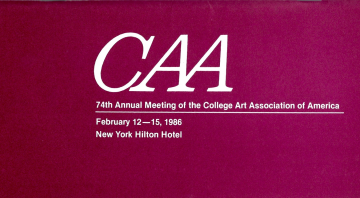

Murmurs and Decisions
For years, discussion has brewed among the CAA board of directors and members about a name change and new branding for the organization. The decision was formally written into the 2015-2020 CAA Strategic Plan.
In spring 2017, work officially began. CAA issued an RFP for the redesign and renaming of the 107-year old organization. The firm Briteweb, which specializes in branding for the social sector, was chosen as the best fit from eight other firms.
Step 1: Renaming
Feedback. Feedback. Feedback. The first step on the path to renaming the College Art Association (CAA) was gathering feedback from our members and stakeholders. A survey went out to all members, current and lapsed. Phone calls and interviews took place with stakeholders and board members. We learned a lot.
“Overall, it seems to me that the goal should be to figure out how to make sure that everyone who has a stake in teaching art, design, art history, curatorial and museum practices at the college level understand that they are included and welcomed—that it is their professional organization.” –CAA member survey response
Feedback we received from our members told us how CAA matters to them, where we can improve, and where we should focus our energy as we move into the future.
Step 2: A Tagline That Fits
Members told us that CAA has to move forward. You told us that we have to be there for the next generations of students and scholars in the arts and humanities. We have to advance the field by supporting the field. Our tagline was born.
“Advancing Art & Design”
We also learned that there was immeasurable value packed into three letters—CAA. We explored different acronyms, new names, and different words to fit CAA. But in the end, it came down to the letters CAA being the sole representation of the organization as it moves into the future, stepping up a role they have already played for decades.
Step 3: A Logo is Born
With our name settled, it was time to design. What does advancing mean visually? How can we encompass the many professions and personalities of our membership in a visual representation? Rounds of designs were reviewed.
We wanted risk, but not too risky.
The new CAA logo includes nods to the frame and page, two crucial elements of our members’ lives. It has dimensionality and flexibility. Just like our members.
CWA Picks for December 2017/January 2018
posted by CAA — Jan 09, 2018
CAA’s Committee on Women in the Arts selects the best in feminist art and scholarship to share with CAA members on a monthly basis. After this combination post, updates will resume monthly.
December Picks
Unfinished Business: Perspectives on art and feminism
December 15, 2017–March 25, 2018
Australian Centre for Contemporary Art
111 Sturt Street
Southbank Victoria
Melbourne, Australia
In the newest exhibition at the Australian Centre for Contemporary Art, Unfinished Business: Perspectives on art and feminist critical and underrepresented practices and debates are examined within contemporary Australian art and society. New commissions, recent works and historical projects are presented from art historians, artist, and theorists from the 1970s to the present.
The exhibition includes painting, performance, photography, film, community engagement and cultural activism to name several mediums. Focusing on the “dynamic formal invention and social engagement of feminist artists,” the exhibit explores gender identity, representation, and intersectional politics through performance, text and media technologies, humor and critique.”
“Asking why feminism is still relevant, necessary and critical, Unfinished Business explores trans-generational legacies, inheritances and shifts, alongside contemporary conditions and concerns – to stimulate new debates and discussions around the ‘unfinished business’ of feminism today.”
November 13, 2017–February 16, 2018
Artist’s Lecture & Reception: January 17, 5 – 8 pm
The Kniznick Gallery
Brandeis University
Women’s Studies Research Center
Epstein Building
515 South Street, Waltham, MA
In this solo exhibition by Clarity Haynes at the Kniznick Gallery at Brandeis University, large-scale painted portraits depicts the history of displaying social power through the painted portrait.
In Haynes’s paintings she features the torso as the site for storytelling, paying homage to women, trans and gender nonconforming people. “”Tattoos, scars, evidence of illness, aging, exposure to sun, childbirth, surgeries, synthetic hormones, moles, birthmarks, stretch marks and veins, all tell a story of a body’s life, and Haynes seeks to portray them larger-than-life and divine.”
The name of the exhibition, Baba Na Gig, or “Old Woman of the Breasts”, is in honor of Baba Yaga, the old woman goddess of Eastern Europe, and the goddess Sheela Na-Gig, or “Sheela of the Breasts.”
In acknowledging the social history and social power of the portrait, Haynes seeks to redistributes power to people outside of cultural norms. “Her years-long process of making each work contributes to a reverence for the way bodies change and redefine what power can be.”
In addition to the artist’s lecture on January 17, 2017, the gallery will hold an event with art historian and museum educator, Annie Storr. Storr will lead an “Exercise for the Quiet Eye” on January 30, 2017 to encourage patient reflection, appreciation, and interpretation.
Solidary & Solitary: The Joyner/Giuffrida Collection
September 30, 2017–January 21, 2018
Ogden Museum of Southern Art
925 Camp Street
New Orleans, LA
In the exhibition Soliday & Solitary at the Ogden Museum of Southern Art the history of art is reinterpreted through African-American artists from the 1940s through the present. The Joyner/Giuffrida collection is primarily focused on abstract art, a “meaningful political focus, rather than stylistic preference.
“For black artists, abstraction is charged with the refusal of representation that is socially dictated, both by racist stereotypes of the dominant culture, and the pressure from within the black community to create positive imagery. Abstract art as a practice embodies the possibility of individual freedom and autonomy, even within larger social identities.”
Among the artists in the exhibition are sonic and visual artist Jennie C. Jones, painter Lynette Yiadom-Boakye, painter and sculptor Shinique Smith along with Kevin Beasley, Mark Bradford, Leonardo Drew, Melvin Edwards, Charles Gaines, Sam Gilliam, Norman Lewis, Glenn Ligon, Serge Alain Nitegeka, Tavares Strachan, and Jack Whitten.
[closed] October 26–December 16
Blum & Poe
2727 S. La Cienega Blvd.
Los Angeles, CA 90034
“Lynda Benglis’ legendary practice began in 1960s New York City, her commitment to merging content and form, subverting the paradigms of Minimalism and Modernism, established her formidable role in contemporary art history as a leader in the Post Minimalism movement. Her iconic works have been coined “frozen gestures”—referencing the body and the landscape, sexual and gender politics—realized in poured latex, wax, polyurethane, ceramics, bronze, paper, video, glass, neon, and more.
Spanning two levels of exhibition space and including the outdoor gardens, here Benglis presents works from a sculptural practice that engenders hybrid compositions, embracing the subjective touch of the artist’s hand and the inextricable link between process, material, and form. Each room features a distinct body of work, showcasing the artist’s multifarious range—including glazed ceramics; examples from her bronze fountain series; large-scale biomorphic aluminum sculptures; a constellation of recent paper wall works; and the eleven-foot phosphorescent cast polyurethane HILLS AND CLOUDS (2014).”
July 8, 2017–January 14, 2018
Museum of Contempoary Art
220 E. Chicago Ave
Chicago, IL 60611
“Woman with a Camera presents photographs by 14 women artists who come from a diverse set of backgrounds and generations, and address various artistic concerns. This intimate show includes established masters of the medium—such as Catherine Opie, Laurie Simmons, and Carrie Mae Weems—alongside exceptional younger artists—including Anne Collier, Xaviera Simmons, and Mickalene Thomas—who use photography to explore facets of politics, history, and identity. Though their practices are disparate, their works draw on three central themes in photography: rendering the human figure, capturing public or private spaces, and commenting on our media-saturated culture.”
Although essentially a show acknowledging the gifts of particular collectors (Sandra and Jack Guthman), the works provide an opportunity to reflect on the heterogeneous practices of a generationally diverse array of artists. Other artists represented: Emily Jacir, Michele Abeles, Marina Abramović, Sophie Calle, Leslie Hewitt, Melanie Schiff, Eve Sussman/Rufus Corporation, and Anna von Hausswolff.
November 11, 2017–January 13, 2018
Kohn Gallery
1227 North Highland Ave
Los Angeles, CA 90038
“A group exhibition featuring seventeen contemporary artists who are revolutionizing the way we visualize conventional gender as exclusively male or female. Through painting, a medium that has traditionally embraced this binary, these artists are pushing the genre in new, unprecedented directions, challenging the ways in which paintings can be used to deconstruct and rewrite conventional notions of personal identity. The exhibition highlights the inter-blending of traditional and figurative abstraction as the foundation for more fluid and inclusive expressions of identity, engendering a new visual pronoun.”
The exhibition attempts to get “beyond the binary” of figurative representation, and the visual hailing of particularly gendered bodies. Painting is the medium of choice, and works like Emily Mae Smith’s Abyss, 2017, challenge easy associations with masculine or feminine imagery. Other works in the show, such as Christina Quarles’s paintings, which are filled with bendy and androgynous bodies, highlight how the figurative can be transformed through formal applications of paint—itself a sometimes viscous and sticky goo.
Artists included: Mequitta Ahuja, Firelei Báez, Hernan Bas, Zoë Charlton, Jonathan Lyndon Chase, Nicole Eisenman, Natalie Frank, Heidi Hahn, Loie Hollowell, Sadie Laska, Jesse Mockrin, Jennifer Packer, Christina Quarles, Nathaniel Mary Quinn, Tschabalala Self, Emily Mae Smith, Jansson Stegner
January Picks
Magnetic Fields: Expanding American Abstraction, 1960s to Today
October 13, 2017–January 21, 2018
January 17, 2018: Gallery Talk, Get the 411 on Abstraction
January 19, 2018: Artist’s Talk with Maren Hassinger
National Museum of Women in the Arts
1250 New York Ave NW
Washington, D.C.
The National Museum of Women in the Arts presents a look at abstract works by twenty-one black female artists. Magnetic Fields: Expanding American Abstraction 1960s to Today features artists born between 1891 and 1981, cutting across generations to unveil under-recognized leaders in abstraction.
“Artists in Magnetic Fields dispel the notion that figurative art is the only means for visualizing personal experience. The titles of their works and their construction methods evoke intense associations. Mary Lovelace O’Neal’s use of allusive titles, such as Racism is Like Rain, Either it’s Raining or it’s Gathering Somewhere (1993), informs the reading of her monumentally-scaled painting while Maren Hassinger similarly uses socio-politically inflected titles and materials—specifically New York Times newspapers—in her textural floor sculpture Wrenching News (2008).”
Artists presented in Magnetic Fields include Candida Alvarez, Betty Blayton, Chakaia Booker, Lilian Thomas Burwell, Nanette Carter, Barbara Chase-Riboud, Deborah Dancy, Abigail DeVille, Maren Hassinger, Jennie C. Jones, Evangeline “EJ” Montgomery, Mary Lovelace O’Neal, Howardena Pindell, Mavis Pusey, Shinique Smith, Gilda Snowden, Sylvia Snowden, Kianja Strobert, Alma Woodsey Thomas, Mildred Thompson, and Brenna Youngblood.
Exhibition programming includes a short gallery talk on Wednesday, January 17, 2018, exploring highlights with NMWA Senior Educator Adrienne L. Gayoso, as well as an in-depth artist’s talk with Maren Hassinger about her work, Wrenching News, created in response to Hurricane Katrina’s aftermath.
LSFF: Radical Softness Through a Haptic Lens: Barbara Hammer and Chick Strand + Q&A
January 13, 2018, 4pm, Cinema 1
The ICA
The Mall
London
The retrospective by the ICA Cinema of the work of experimental filmmakers Chick Strand, and Barbara Hammer, a pioneer of queer cinema, explore the idea of ‘radical softness’- “the power in being both abrasively feminine and openly vulnerable, subverting emotion from weakness to strength.”
“Thematically, my work deconstructs a cinema that often objectifies or limits women,” Barbara Hammer says on her website. “My work makes these invisible bodies and histories visible. As a lesbian artist, I found little existing representation, so I put lesbian life on this blank screen, leaving a cultural record for future generations.”
“Strand (1931-2009) played a vital role in the 1960s Bay Area filmmaking community both through her work and her involvement in the co-founding of Canyon Cinema—which would become the San Francisco Cinematheque—with friend Bruce Baillie in 1961. Strand also taught film for twenty-five years at Occidental College in Los Angeles, influencing a generation of filmmakers.” (http://hcl.harvard.edu/hfa/films/2016marmay/strand.html)
The screening will feature Dyketactics (1974, 4 mins), Superdyke Meets Madame X (1975, 20 mins) both by Barbara Hammer, and Soft Fictions by Chick Strand (1979, 54 mins).
January 21, 2018–June 3, 2018
Pasadena Museum of California Art
490 East Union Street
Pasadena, CA
In the exhibition, The Feminine Sublime, the Pasadena Museum of California Art presentes a counter-narrative “that upends previous ideas of the sublime in painting with a unique feminist perspective.”
“With their large-scale artworks, the artists situate the viewer within the annihilating and terrifying effects of global climate change, nuclear catastrophe, 9/11, consumerist environmental degradation, and even post-apocalyptic landscapes. Though they articulate ideas of dystopian insecurity, fragmentation, and collapse, all of the works paradoxically invoke transformation, transition, and the possibilities for painting to still promote the kind of skepticism instrumental for the renewal of human consciousness.”
Artists include Los Angeles-based painters Merion Estes, Yvette Gellis, Virginia Katz, Constance Mallison, and Marie Thibeault.
Esther Ferrer: All Variations are Valid, Including This One
October 26—February 25, 2018
Museo Nacional Centro de Arte Reina Sofia
Calle Santa Isabel, 52
Madrid, Spain
A member of the avant-garde performance-based group Zaj, Ferrer’s artistic output is experimental (ranging across many media) and focused (prime numbers and education are recurring themes). In this exhibition, which privileges archival materials and Ferrer’s installations alike, the Museo Reina Sofia gives the monographic treatment to an artist well-known in Spain, but underrecognized abroad.
One of the central figures in Spanish performance art, Ferrer’s engagement with the conceptual structures of chance and repetition are enduring concerns. This exhibition also gathers together a group of Ferrer’s theoretical writings and speeches in the accompanying catalog.
Polly Apflebaum: Dubuffet’s Feet My Hands
November 24, 2017—February 2, 2018
Frith Street Gallery
17-18 Golden Square
London
“This exhibition is the latest in a series of installations that incorporate hand-woven carpets, ceramics, and immersive colour. […] Curator Kate McNamara has noted that carpets are the logical conclusion of Apfelbaum’s longstanding engagement with the floor, with pliable supports, fabric and decorative art traditions.
“For this installation, Apfelbaum worked with weavers in Oaxaca, Mexico, where the Zapotec people have been weaving textiles for over 2,000 years. Entitled Dubuffet’s Feet, this floor work is based on a small drawing titled Footprints in the Sand by Jean Dubuffet from his 1948 sketchbook El Golea II, which the artist saw at the Museum of Modern Art, New York. Apfelbaum has translated the image into a series of hand-woven rugs, each depicting an enormous footprint of a figure who would be over 100 feet tall. There are four carpets, two with left feet and two with right, aligned as parallel pairs, implying the trace of two giants. While Apfelbaum’s carpets are woven in earth tones that may evoke the 1970s, they also correspond with the sand in which Dubuffet’s footprints may have been left, and thus the natural landscape […]
“The parallel series My Hands has evolved from Apfelbaum’s ongoing experiments with glazed ceramics. They take their inspiration from the ‘floating hand of God’ in the mosaics of the basilica of Sant’Apollinare Nuovo in Ravenna, which she visited during a residency at the American Academy in Rome in 2013. Apfelbaum was fascinated by this image of the disembodied hand as the symbol of creation and intervention. Apfelbaum has used her own hand as a template for these works, creating a relationship to the artist’s touch while also dealing with ideas about craft and making, from prehistoric times to children’s pre-school handprints […].”
Sexuality Stories
October 20, 2017—February 14, 2018
Guerrilla Girls: Graphic, 1985-2017
September 29, 2017—February 14, 2018
MASP
Av Paulista, 1578
São Paulo, Brazil
There’s something delicious about a Guerrilla Girls retrospective holding space with a much more broadly conceived exhibition on sexuality—as the group of anonymous gorilla-mask-wearing feminists have had much to say about sexuality (and the depiction of it) across art’s histories and in the contemporary moment. Staged in the museum Lina Bo Bardi built in 1968, these shows serve as counterpoints, with the Guerrilla Girls retrospective underlining the radicality of the team-curated collections exhibition, Sexuality Stories.
In one of the new works on display at MASP, the Guerrilla Girls update their famous Do Women Have To Be Naked… poster, this time addressing São Paulo’s Museum of Art (where 60% of the nudes are women, but only 6% of the artists are). The catalog for the exhibition does the important work of translating the Guerrilla Girls’ mostly text-based work into Portuguese. The exhibition is curated by Adriano Pedrosa, artistic director of MASP, and Camila Bechelany, curator of Latin American Art.
For Sexuality Stories Pedrosa and Bechelany curatorial efforts are combined with those of Lilia Schwarcz, adjunct curator of MASP stories, and Pablo León de la Barra. Together they have programmed a variety of solo shows in advance of this installation (the Guerrilla Girls exhibition is only one). The intent, according to the curators, is to affirm a “respect for the other, difference and artistic freedom.” In gathering together historical works from across MASP’s collections, as well as those from contemporary artists, Sexuality Stories addresses sexuality as one of the enduring concerns of representation.
Call for Contributions to RAAMP (Resources for Academic Art Museum Professionals)
posted by CAA — Dec 12, 2017
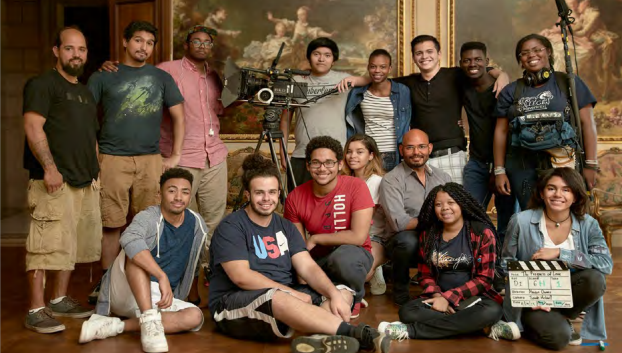
Honor students from The Cinema School at The Frick Collection, 2016, from AAMD’s “Next Practices in Diversity & Inclusion” PDF in RAAMP. Photo: Michael Bodycomb
Given the spirited discussion taking place on a number of curatorial listservs and websites, RAAMP (Resources for Academic Art Museum Professionals) invites submissions to add to its publicly accessible online archive for individuals working in academic art museums.
Examples include museum strategic plans, campaigns for outreach to campus communities, and strategies for diversity and inclusion in the academic art museum, and include PDFs, links, videos, and more.
Click here to submit resources.
You can also browse the existing resources, submit updates, or join the conversation on Humanities Commons.
What is RAAMP?
RAAMP serves to promote scholarship, advocacy, and discussion related to the role of academic art museums and their contribution to the educational mission of their parent institutions. To this end, it functions as a publicly accessible online repository; it collects, stores, and shares resources.
RAAMP is a project of the CAA with support from The Andrew W. Mellon Foundation.
Africa at the Quai Branly Museum and the Mohammed VI Museum for Modern and Contemporary Art: Challenges for Exhibitions of African Art
posted by CAA — Nov 16, 2017
Colette Apelian, an art historian based in Rabat, Morocco and Los Angeles, California, was invited to submit the following article by Pearlie Rose S. Baluyut, a member of CAA’s International Committee. Apelian holds a PhD in art and architectural history and an MA in Islamic studies from UCLA.
Do museums fail visitors and benefactors when they allow the use of objects to present what many might consider selective histories and definitions of identities? The answer may well be yes, a response that struck me after I visited Picasso Primitive or Primitive Picasso (Picasso Primitif) at the Quai Branly Museum (Musée du Quai Branly; MQB) in Paris, France (March 28–July 23, 2017) and Africa in the Capital City (L’Afrique en Capitale) at the Mohammed VI Museum for Modern and Contemporary Art (Musée Mohammed VI d’Art Moderne et Contemporain; MMVI) in Rabat, Morocco (March 28–July 31, 2017).
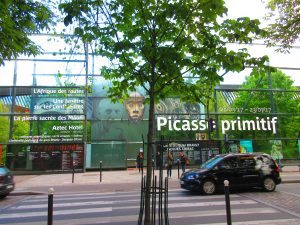
Quai Branly Museum façade. Photo by author.
At the MQB, what can be described as Pablo Picasso’s peccadillos were vaulted as examples of artistic genius and the result of his contact with African artifacts. As visitors walked through the exhibition, they could see Picasso’s art and writings, or reproductions thereof, juxtaposed with African masks, sculptures, and seminude postcard representations of Malinke and Sudanese women. The exhibition included objects Picasso collected, viewed in the Trocadero Ethnography Museum, and/or traded with fellow, mostly male, artists. Curatorial wall texts and a brochure in French and the occasional English explained how Picasso’s figural abstraction defined modern art.
Still, the exhibition could have used more clarification. I wondered why, especially in light of displays in other Parisian museums, the MQB thought visitors would find the Picasso-great-man and artist myth appropriate. The privileging of Picasso and his primitivism in an undefined modern art history was underexplained. Most of the nude bodies and, according to wall texts, the “disfigured” “monster” faces he created were predominantly of females with apparently unremarkable lives or histories beyond Picasso’s use. The suggestion that Picasso made tableaus of stylized penises in response to his exposure to African statues with erect phalluses did not seem to adequately explain his fascination with human sexuality.
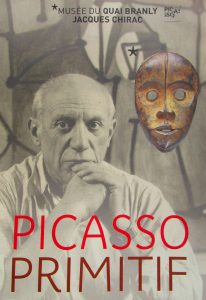
Picasso Primitive brochure cover detail. Photo by author.
Perhaps odder still was how the MQB left unpacked and decontextualized the notion of the primitive. The museum’s (and/or Picasso’s ?) definition all but ignored the history of this term and, as such, the discourse about it and the Other. In so doing, the show affirmed yet again an ethnocentric characterization of the MQB that James Clifford, among others, criticized the museum for entrenching after its 2006 opening. (See James Clifford, “Quai Branly in Process,” October, Spring 2007, 3–23.) The effects of refusing to detangle and define primitive were compounded by the relative lack of wall and brochure text explaining the history, circumstances of acquisition and display, and the socioreligious significances of most masks and statues shown or referenced in the exhibition. It was compounded by the MQB not sufficiently clarifying the sociopolitical and economic contexts in which Picasso traded images of unclothed Africans and created and sold art. In the 2010 Spectacular Art of Jean-Léon Gérôme exhibition at the J. Paul Getty Center in Brentwood, California (June 15–September 12, 2010), visitors learned that Gérôme’s prurient Orientalism was cultivated in relation to the contemporary European marketplace. The perhaps unintended impression that Primitive Picasso organizers hoped to titillate for monetary profit at the expense of the Other was accentuated by the absence of a similar analysis, if indeed the artworks on display were created for public, not private, consumption. Consumption was also underclarified.
More explanation was additionally necessary in the wall texts and brochures for Africa in the Capital. The largest section of the show was staged in the museum named after the king of Morocco, Mohammed VI. Here, visitors walked through rooms of paintings, sculpture, and photography that, according to one brochure, celebrated African creativity, African identity, African culture, the African art scene, and, in the case of at least one artist, humanity removed from racial identifiers. Exhibition materials informed us that the works of art were created by North and/or sub-Saharan Africans, including artists born and/or living off the continent. One example is the Moroccan-French photographer Leila Alaoui, who died shortly after a 2015 Burkina Faso terrorist attack while she was on assignment for Amnesty International. She was born in Paris and resided and worked in Europe, the United States, and Morocco. Alaoui, with her strong sense of injustice and interest in immigration, would probably note that the ability of some artists to easily move across borders is an elite privilege, an important distinction I could not find in exhibition materials. I could also see little discussion about the influences and significance of living and making art in diaspora cultures. The contradictions of an exhibition that was meant to celebrate diversity, yet included artists based upon ancestry alone, appeared lost on the organizers.
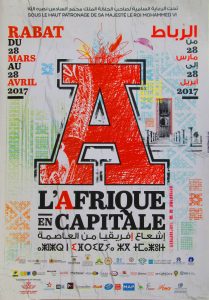
Africa in the Capital brochure cover. Photo by author.
Though the organizers intended Africa in the Capital City to celebrate African identity and creativity, the March 2017 opening and governmental support suggests an ulterior motive: to publicize Morocco’s reentry into the African Union (AU), made official in January 2017. The membership signifies a majority of AU member states’ acceptance of Morocco’s claims to the Western Sahara and its natural resources, a point of contention resulting in Morocco’s exit from a precursor to the AU and, over the decades, international condemnation of what former United Nations Secretary-General Ban Ki-moon called the Moroccan occupation. The controversy behind Morocco’s AU membership and actions in the Western Sahara was not part of the exhibition.
Also difficult to locate were critical artworks or narratives about contemporary Africa. One might conclude that there are no artworks that comment on accusations of corruption and cronyism, misuse of the environment, or violations of human rights, not to mention a lack of development; genocide; violence against women, the LGBT community, and minorities; and, of course, forced displacement and illegal immigration. The lacunae were all the more bizarre considering the inclusion of Alaoui, who depicted sub-Saharan immigrants in her 2014 Marrakesh Biennial submission Crossings and other artwork. As painfully indicated by the circumstances surrounding her demise and the deaths of African, European, and United States military and civilians, sticking one’s head in the proverbial sand cannot make problems disappear. Worse, the silence, like the silence at the MQB, arguably revictimizes her and others. The silence ignores the legacy of their work and sacrifice while leaving a door open to future transgressions. It is frankly unbefitting Morocco’s role and influence as an AU member in an exposition at a museum named after Morocco’s monarch and an exposition in 2017.
Again, I wonder if the MMVI and the MQB failed patrons, benefactors, and themselves. Perhaps we can ask the four vendors across the busy highway in front of the MQB on the day I visited. Of African descent, they were placing their wares for sale—miniature reproductions of the Eiffel Tower and similar iconic trinkets—on corded ground cloths used to collect items quickly should the police arrive to chase them away.
Candidates for CAA’s 2018 Board of Directors Election
posted by CAA — Nov 09, 2017
CAA’s Nominating Committee met in early October 2017 to review the candidates who have applied to run in CAA’s Board of Directors election for the term 2018-2022. The Nominating Committee selected the following six candidates, four of whom will be elected to Board service. In the coming weeks, CAA will post their full biographies for consideration by the CAA membership.
Laura Anderson Barbata is a practicing, trans-disciplinary artist living and working in Brooklyn and Mexico City. Her work is intended to connect various cultures through the platform of contemporary art. Her art engages creative practices that promote dignity, shared values, diversity, and collaboration through reciprocal exchange of knowledge. Among many unique projects, she has worked with the Yanomami of the Venezuela Amazon to document their oral history, overseen collaborative work with stilt dancing groups from Trinidad and Tobago, Brooklyn and Oaxaca and directed a 10-year effort to repatriate the remains of a Mexican Opera Singer. Ms. Barbata has extensive business expertise, as director of image and concept designer for a chain of 50 restaurants throughout Mexico. She was Vice President of the company and worked to protect the interests of the shareholders until the business was sold. Ms. Barbata feels she offers a unique perspective – having international business experience as well as maintaining a career as an artist.
Audrey G. Bennett is a full professor in the Department of Communication and Media, and director of the interdisciplinary graduate program in Communication and Rhetoric at Rensselaer Polytechnic Institute. She was a 1996 recipient of a CAA Professional Development Fellowship and is currently a member of CAA’s Inaugural Committee on Design. From 2002-2010 she was a member of the Board of the Upstate New York chapter of the AIGA, the professional association for design where she served in a number of leadership roles. She is a former 2015 Andrew W. Mellon Distinguished Scholar, University of Pretoria, South Africa. Prof. Bennett secured funding for and founded the Global Interaction in Design Education (GLIDE), a biennial, virtual design conference. She would like to assist CAA in diversifying its membership culturally and intellectually.
Dahlia Elsayed is an Associate Professor of Fine Arts in the Humanities Dept. at CUNY-LaGuardia Community College. She is a practicing artist who combines text and imagery to create visually narrative paintings that document internal and external geographies. Her work is influenced by conceptual art, comics and landscape painting and cartography. She is particularly interested in attracting and welcoming the vital constituency of community college faculty and students to CAA. Furthermore she sees opportunities to facilitate interactions between community colleges, senior colleges and graduate programs to strengthen best practices and continuity.
Alice Ming Wai Jim is Associate Professor in Contemporary Art and Concordia University Research Chair in Ethnocultural Art Histories at Concordia University in Montreal, Quebec, Canada. She is the founding co-editor of the international scholarly journal, “Asian Diasporic Visual Cultures and the Americas.” Alice is an art historian, curator and cultural organizer in the fields of diasporic and global art histories, media arts and curatorial studies. Focusing on Asian Canadian and African Canadian artists, she has curated exhibitions of over fifty artists of color and Indigenous artists and organized major scholarly events within academic settings and for the broader arts community in Canada and internationally. She is also involved in a leadership capacity in several formal partnerships involving international networking and community building initiatives, with a strong commitment to research and social justice. Alice would like to work toward increasing the visibility of members from diverse cultural communities, strengthening international exchanges, and expanding critical capacities for art historical scholarship and critical visual culture studies on and by ethnic minority and Indigenous peoples across the Americas and internationally.
Richard Lubben is Dean of the Arts Division at Lane Community College in Eugene, Oregon. He is a painter, whose recent work consists of a series of large format abstract oil paintings examining visual transitions of landscapes through seasonal changes, memories of nature and delicate ecosystems. He was awarded a Fulbright Visiting Research Chair in Human Rights and Social Justice at the University of Ottawa in 2013. He has served on CAA’s Task Force on Advocacy, been on panels at CAA’s Annual Conference and is currently the Chair of CAA’s Education Committee. Lubben urges the inclusion of representatives from community colleges on CAA’s board but even more importantly attracting to CAA the thousands of 2-year institutional members, and potential individual members, associated with the nearly 1500 community colleges across the United States.
Walter Meyer, Professor of Art History at Santa Monica College, a 2-year community college in California. His degree is early 20th century art, specializing in Eastern Europe and Russia. He has taken on a number of leadership positions at SMC including co-chairing the Technology Planning Committee . He is President of the Art Historians of Southern California, and former board member of the Craft & Folk Art Museum in Los Angeles. Currently, he serves on CAA’s Professional Practices Committee. Meyer believes in the mission of the community college system and its ability to help art and art history programs close the equity gap with under-represented populations on college campuses.
Indigenous Futures in Art Journal
posted by CAA — Oct 23, 2017
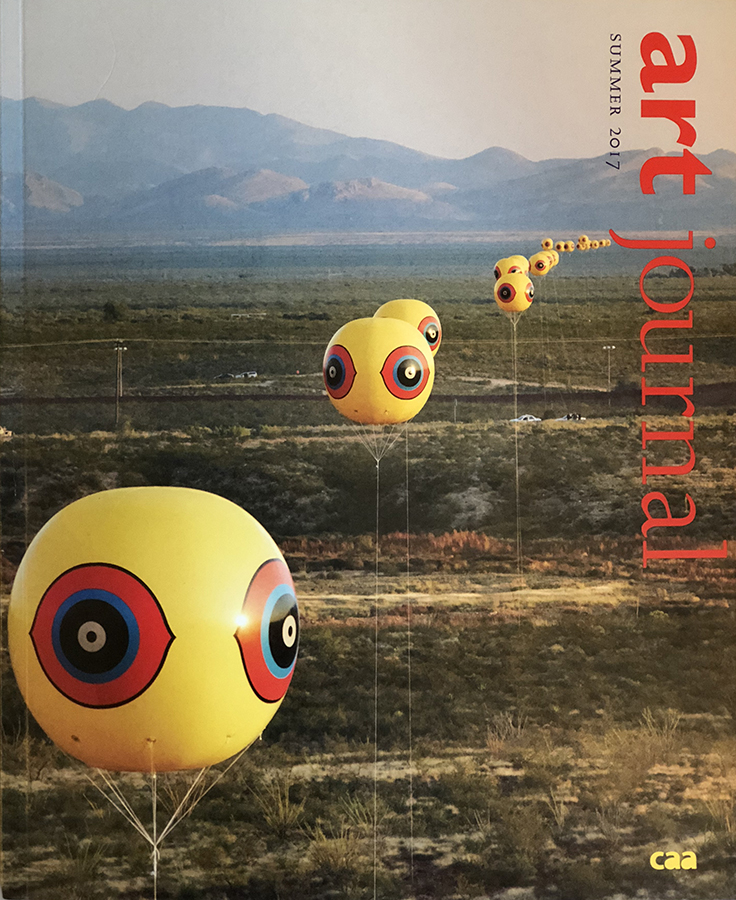
Postcommodity, Repellent Fence, 2015, installation view (artwork © Postcommodity; photograph by Michael Lundgren provided by Postcommodity)
Recent years have seen a boom in the creation of new art by Indigenous artists across North America—and a concomitant surge in scholarship about this art. The recently published issue of Art Journal is devoted to both the art and the research. In addressing the theme “Indigenous Futures,” editor-in-chief Rebecca M. Brown turned to the scholars Kate Morris and Bill Anthes as guest editors.
Works by dozens of Indigenous artists are featured in the issue, among them Kay WalkingStick, Kent Monkman, Shan Goshorn, Rebecca Belmore, Cheryl L’Hirondelle, Will Wilson, and Edgar Heap of Birds. The artist collective Postcommodity created a project for the issue that includes the covers. Two artists wrote substantial texts: Jolene Rickard explores the theme of sovereignty in Indigenous art, while Marie Watt enjoys a frank chat with Joseph Beuys’s Coyote—who is amazingly au courant about today’s art.
In addition to Morris and Anthes, the scholars Jessica L. Horton, Dylan Robinson, and Sherry Farrell Racette provide insights into bodies of work by specific artists. A strong curatorial thread runs through the issue as well, with essays by Candice Hopkins and Heather Igloliorte; a magisterial essay by the curators Kathleen Ash-Milby and Ruth B. Phillips traces the history of critical exhibitions in North American museums and galleries since 1992, the year of the controversial “celebration” of the Columbus quincentennial.
The Reviews section of the issue features a 2015 book by W. J. T. Mitchell (reviewed by Caroline A. Jones), a substantial anthology on the postwar avant-garde in Scandinavia (by Karen Kurczynski), the exhibition and catalogue of Hélio Oiticica: To Organize Delirium (by Camila Maroja), a multiauthor and -artist volume on the Indian city of Chandigarh (by Tracy Bonfitto), and the exhibition and catalogue of Leap Before You Look: Black Mountain College 1933–1957 (by Erica DiBenedetto).
CAA sends print copies of Art Journal to all institutional members and to those individuals who choose to receive the journal as a benefit of membership. The digital version at Taylor & Francis Online is currently available to all CAA individual members regardless of their print subscription choice.
News from the Art and Academic Worlds
posted by CAA — Sep 27, 2017
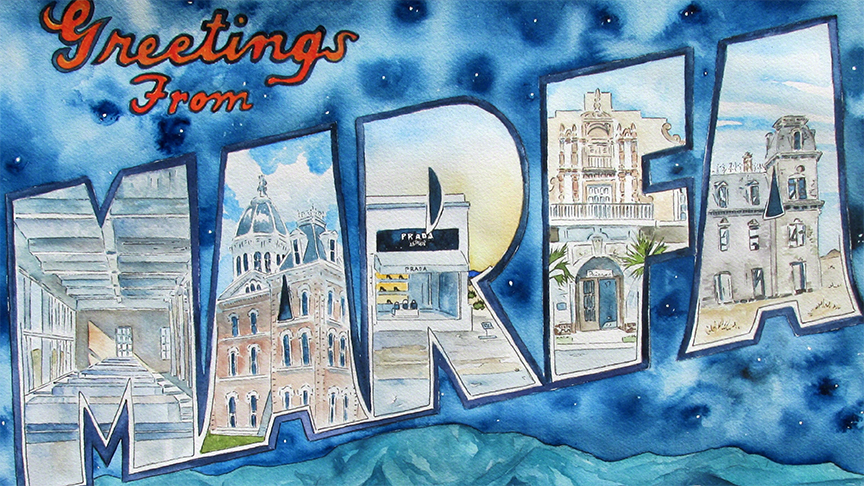
Scott Winterrowd
Greetings from Marfa, 2015
Ro2 Art
Each week CAA News summarizes articles, published around the web, that CAA members may find interesting and useful in their professional and creative lives.
Corrective curatorial practice? Sensationalizing sexuality to boost attendance figures? Can the most transgressive feminist art practices really be exhibited for reasons founded on the intrinsic value of the work alone?
Featuring feminist content previously held to be too graphic may raise more questions than anticipated. “Frieze Frame: Graphic Sex and Female Sexuality under Spotlight at Art Fair.” (Read more from The Guardian).
The New Age self-help movement meets art.
Proving again that our culture regards creativity as a path to the authentic self and a means to counteract the lack of inspiration provided by our daily life. Scott Indrisek, “Find Your Inner Donald Judd at Marfa’s New Art Camp for Adults.” (Read more from Artsy).
Civil Identity and Art
The exercise of cultural policy on a massive urban scale is being implemented and explored in cities besides Los Angeles with its mega-multi-exhibition Pacific Standard Time program. Consider the interviews conducted by Sophia Olivia Sanan in “A Tale of Cultural Policy in Four African Cities.” (Read more from This Is Africa).
Making art accessible to as many publics as possible.
The seeds of social practice and cultural policy in art education, related to the legacy of Jane Addams’s Hull House, are discussed by Lisa Lee, Director of the School of Art and Art History at the University of Illinois at Chicago, with the hosts of the Bad at Sports podcast. Episode 600: Lisa Lee. (Read more from Bad at Sports).
The world’s first painted feature film.
Receiving standing ovations at film festivals and with assistance from the Van Gogh Museum in Amsterdam, Loving Vincent incorporates almost 1,000 separate canvases to consider the artist’s last days. Eileen Kinsella, “How Two Directors, 125 Artists, and Some ‘Crazy-Rich’ Van Gogh Fans Made ‘Loving Vincent’ the World’s First Painted Feature Film.” (Read more from Artnet).
Pacific Standard Time Sampler.
The latest edition of Southern California’s multivenue exhibition project has debuted with plenty of press coverage. Here is an assessment of just one of the exhibitions comprising Pacific Standard Time LA/LA. Julian Kreimer, “Drastic Times.” (Read more from Art in America).
Why does art make you feel so much?
The answer resides in your brain as much as what is unfolding before your senses. The inquiry is increasingly a focus of neuroaestheticians now discovering answers about the fundamental attractions of creativity. Sarah L. Kaufman et al., “This Is Your Brain On Art.” (Read more from The Washington Post).
The birth of the art market.
An exhibition tracing the origins of the art market details how artists, dealers, and the buying public established the mechanisms that still characterize the contemporary system. “Exhibition Devoted to the Birth of the Art Market in the Dutch Golden Age Opens.” (Read more from artdaily).




